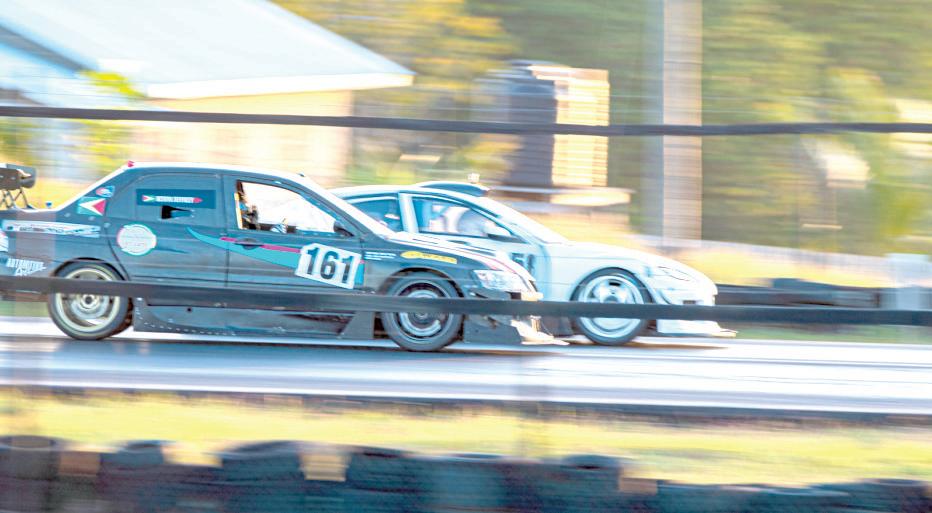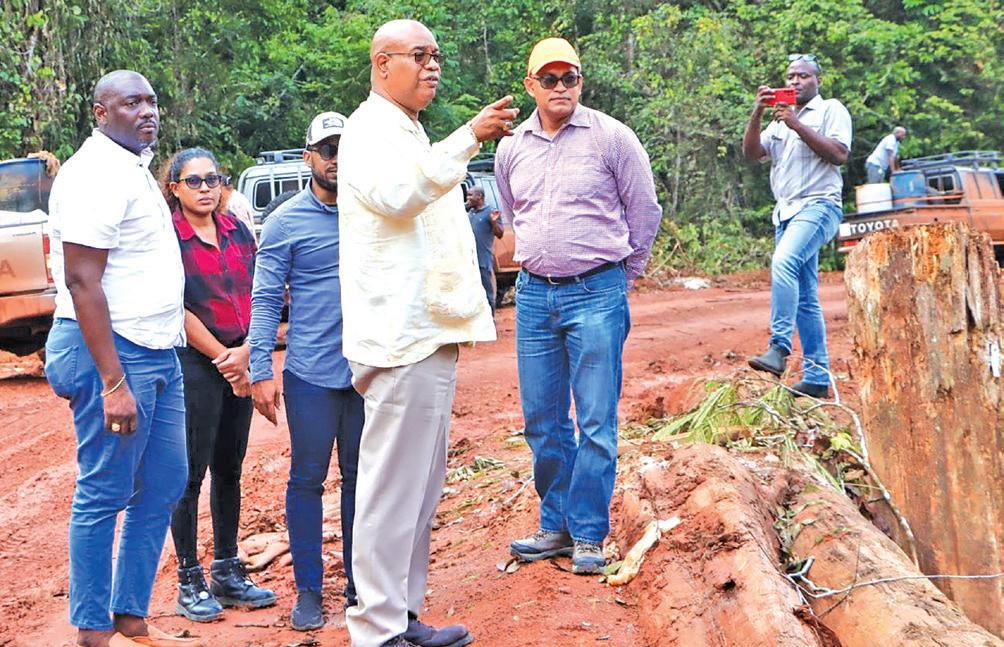



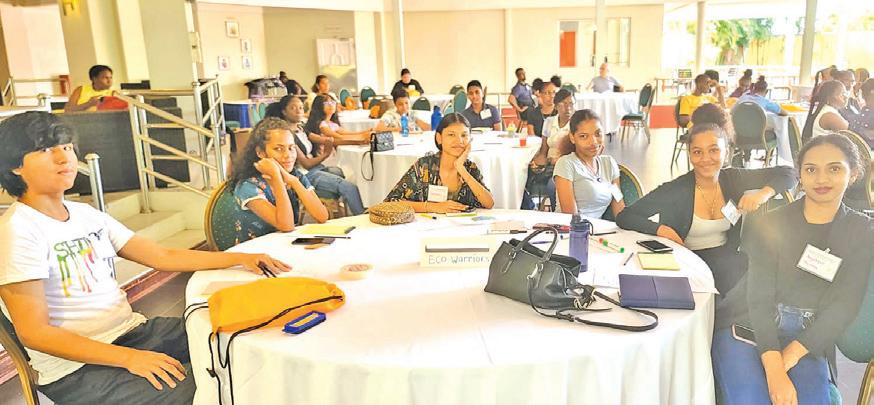

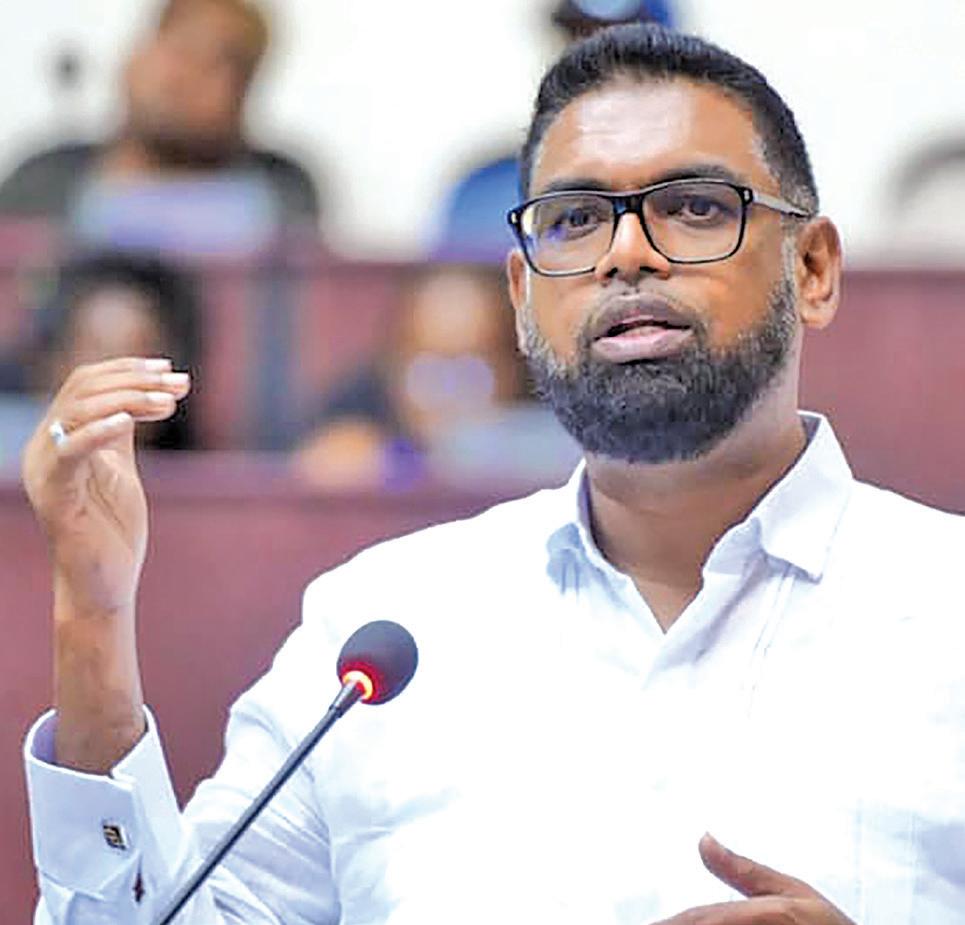
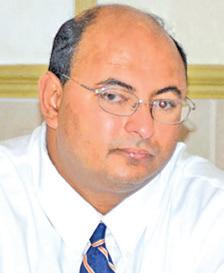
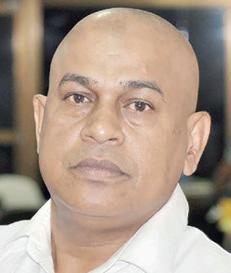


“It is highly disrespectful” –Edghill












“It is highly disrespectful” –Edghill
Brazilian federal authorities are investigating a Guyanese businessman suspected of laundering over R$80 million (US$16.4 million) worth of illegally mined gold through several companies operating in the foodstuff and medical supply industries.
According to an article published by the Ministry of Justice and Public Security, the investigation, known as Operation
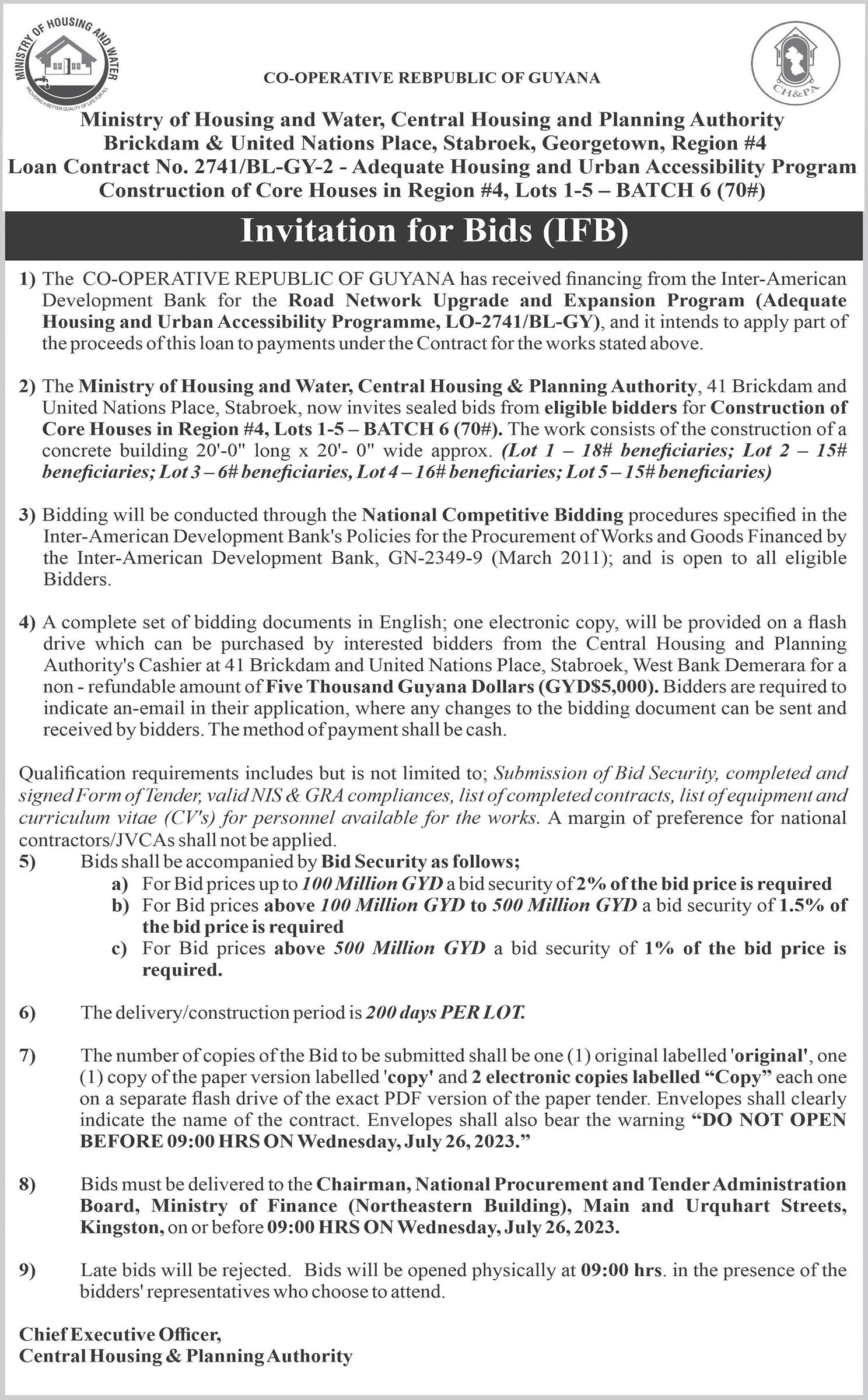
Vanglória, focuses on individuals believed to have facilitated the movement of illegally sourced gold from neighbouring Guyana into Brazil.
The probe was initiated after authorities discovered the involvement of an alleged Guyanese businessman, who has ties to the gold mining industry in Guyana and conducts business in Brazil under suspicious circumstances.
As such, the association linked the businessman to a Manaus-based company registered as a foodstuff provider, but upon investigation, it was revealed that the listed address was allegedly a vehicle shop operating under a different registration.

Federal Police agents suspect that the Guyanese businessman has a Brazilian partner who aided in the movement of funds through the companies.
One of these entities, purportedly involved in

the trade of hospital supplies, has allegedly laundered over R$60 million (US$12.3 million) worth of gold through its operations, despite having no physical presence at its registered address. Brazil, due to its size and numerous bordering countries, has become a hotspot for gold smuggling activities. With nearly 200 ports along the Atlantic Ocean, the country serves as an ideal starting point for criminal organisations seeking to smuggle gold out of South America and into lucrative markets like the United States, Asia, and the Middle East. It is estimated that around 30 tonnes of gold, valued at approximately $1.86 billion, is illegally extracted from Brazil each year.
As part of Operation Vanglória, Brazilian authorities said they have executed three search and seizure warrants in their efforts to locate the gold.


The Demerara Harbour Bridge will be closed to vehicular traffic on: Wednesday, July 12 – No retraction and Thursday, July 13 – 01:00h – 02:30h.
The Berbice Bridge will be closed to vehicular traffic on:
Wednesday, July 12 – 12:30h – 14:00h and Thursday, June 13 – 13:35h – 14:05h.








Parika and Supenaam departure times – 05:00h, 10:00h-12:00h, 16:00h, 18:30h daily.


There will be thundery showers and sunshine during the day. Expect light rain showers at night. Temperatures should range between 23 degrees Celsius and 30 degrees Celsius.

Winds: East North-Easterly to North-Easterly between 1.34 metres and 4.02 metres.
High Tide: 12:17h reaching a maximum height of 2.23 metres.
Low Tide: 18:08h reaching a minimum height of 1.0 metre.

Guyana is well on course to becoming the fourth largest offshore producer of oil in the world by 2035, which will put it ahead of countries like the United States (US), Mexico and Norway in terms of barrels of oil produced.
This is according to the United Nations Economic Commission for Latin America and the Caribbean (ECLAC), which has projected that Guyana will overtake these three oil producers to become the world’s fourth largest oil producer by 2035.
According to ECLAC in their latest report on Foreign Direct Investment (FDI), US$10 billion in oil investments were announced in Guyana for 2022. This is a steep increase considering that in 2020 US$8 million in oil investments were announced, preceded by US$33 million in 2021.
“Following the first discoveries of offshore oil deposits in 2015, arising from the exploration and exploitation activities of ExxonMobil of the United States, Guyana has been expanding not only its oil reserves each year, but also the oil produced and the revenues derived from the resources,” ECLAC said.
– is on track to come online by the end of 2023 with a gross production capacity of approximately 220,000 bpd. While this may be the gross production capacity, it is expected that the startup will see a much smaller number of oil barrels being produced. For instance, when Liza phase two started in 2022, it was producing significantly less than its current production.





“The share of the oil, coal and natural gas sector in Guyana’s FDI flows averaged 71 per cent between 2016 and 2021, when the first investments linked to discoveries in the Stabroek block were made. Projections indicate that Guyana will consolidate its position as the world’s fourth largest offshore oil producer by 2035, ahead of countries such as the United States, Mexico and Norway.”
According to the report, Guyana’s oil is very competitive, with light crude, low exploration costs and emissions below the world average. The report also noted that royalties and tax revenues from exploration in Guyana are expected to total US$13 billion by 2029.
“In a hydrocarbon market that is increasingly competitive, in terms of both price and carbon intensity, Guyana’s oil is highly competitive. Most of the resources extracted in the country are of the light variety, with low exploration costs and an emissions intensity below the world average.”
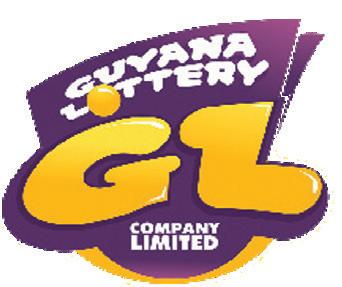
“Royalties and tax revenues from exploration of the resource are projected to total US$13 billion by 2029 (Forbes,?2020). These figures highlight the economic importance of oil production for Guyana, and the potential for the country’s future productive development represented by the use of these resources,” ECLAC further said.
To date, there have been some 45 oil discoveries offshore Guyana, since the first oil find by oil giant ExxonMobil in 2015. Exxon
has said it anticipates at least six projects offshore Guyana will be online by 2027.
ExxonMobil, through its local subsidiary Esso Exploration and Production Guyana Limited (EEPGL), is the operator of the Stabroek Block and holds 45 per cent interest in the block. Hess Guyana Exploration Ltd holds 30 per cent interest, and CNOOC Petroleum Guyana Limited, a wholly-owned subsidiary of CNOOC Limited, holds the remaining 25 per cent interest.

Currently, Liza phase 1 and phase 2 developments in the Stabroek Block are operating at a combined gross production capacity of more than 360,000 barrels of oil per day (bpd) using the Liza Destiny and Liza Unity floating production, storage and offloading (FPSO) vessels, respectively.
The third development in the Stabroek Block – Payara
Meanwhile Yellowtail – the fourth development – is slated for 2025 with a production capacity of some 250,000 bpd. Both these development projects have been approved by the Guyana Government.
Uaru is the fifth development and is expected to come online at the end of 2026 with a gross production capacity of approximately 250,000 bpd with first oil anticipated at the end of 2026. The development plan for Uaru was submitted for Government approval in November 2022 and it has also received project approval.
Outside of ExxonMobil and its partners – which has to date been the country’s only producer – Canadian companies CGX Energy and Frontera recently discovered oil in the Corentyne Block. The Ministry of natural resources has noted that this latest oil find reaffirms the country’s hydrocarbon potential outside of the highly productive Stabroek Block. (G3)
to be world’sLiza Destiny was Exxon’s first FPSO in the Stabroek Block Editor: Tusika Martin
News Hotline: 231-8063Editorial: 231-0544, 223-7230, 223-7231, 225-7761
Marketing: 231-8064Accounts: 225-6707

Mailing address: Queens Atlantic Industrial Estate Industrial Site, Ruimveldt, Georgetown
Email: news@guyanatimesgy.com, marketing@guyanatimesgy.com

Sometime ago this newspaper reported that 38 adolescent mothers completed the reintegration programme though the Education Ministry.
These young mothers have a chance to be gainfully employed and take care of their children. This opportunity gives adolescent mothers the prospect of a good education, thus providing them with the foundation to have a better life.
Sometime ago, after reports surfaced in the media that teenage girls, aged 13 and 15, from the Lower Pomeroon area, Region Two (Pomeroon-Supenaam), had become pregnant and had subsequently given birth to twins, there was much uproar about the lack of will at the level of policy-makers, and the lack of guidance at the social level, to help prevent teenage pregnancy. Also, this publication had reported, some time ago, of a 14-year-old girl, also from the Pomeroon River, who was hospitalised after she had tried to abort her unborn baby and had injured herself. This is a typical example of what happens when one becomes pregnant at a very young age, and possibly gets into a state of depression due to that pregnancy.
The fact that our students, who ought to be at school educating and preparing themselves to face life’s challenges, are engaging in such life-changing activities is very worrying. Our adolescents would certainly have to face the consequences of these choices later down the road. The resulting problems could be many; for example: severe health complications for both the mother and child, and serious social and economic problems.
The World Health Organisation (WHO), in one of its reports, had stated that adolescents aged 10-19 years account for 11 per cent of all births worldwide, and for 23 per cent of the overall burden of disease due to pregnancy and childbirth.
The Organisation has reported that 14 per cent of all unsafe abortions in low- and middle-income countries are among women aged 15-19 years. About 2.5 million adolescents have unsafe abortions every year, and adolescents are more seriously affected by complications than are older women.
Many health problems are particularly associated with negative outcomes of pregnancy during adolescence. These include anaemia, malaria, HIV and other Sexually Transmitted Infections (STIs), postpartum haemorrhage, and mental disorders such as depression.
Likewise, the social problems, both on families and the community, are many. Many girls who become pregnant have to leave school. This has long-term implications for them as individuals, their families, and communities. For example, when an adolescent girl becomes pregnant, her entire life is affected, as her focus can no longer be her academic studies; she would now have to dedicate all her energies and resources to child rearing and caring.
That said, we believe that in many of these cases, especially in girls under 15, such pregnancies are not the result of a deliberate choice, but rather an absence of choices and of circumstances beyond a girl’s control. Early pregnancies reflect powerlessness, poverty and pressures – from partners, peers, families, and communities. Hence, there is need for approaches that build girls’ human capital – helping them to make decisions about their lives, including matters of sexual and reproductive health; and offer them real opportunities, so that motherhood is not seen as their only destiny.
Girls need to have access to both sexual and reproductive health services, and to the right kind of information, so that they can make informed choices about their own lives. In many communities, especially in the hinterland areas, these services are lacking.
In May 2011, the World Health Assembly adopted a resolution urging member states to accelerate actions to improve the health of young people. It included these specific measures: reviewing and revising policies to protect young people from early child-bearing; providing access to contraception and reproductive health-care services; and promoting access to accurate information on sexual and reproductive health.
It is very commendable that the Education Ministry continues to help teen moms through the Re-integration of Adolescent Mothers programme. This affords teen mothers the opportunity to be productively employed, and for those who choose to re-enter the formal school system, they can do so successfully.
Relative to its assets
— talented people; sun, sea, and sand; minerals, like bauxite and gypsum; agricultural produce, like Blue Mountain coffee; and the country's proximity to the world's richest markets in North America — Jamaica's economy may be the world's most underperforming. One of the reasons for this is the tendency to go for growth often at the expense of development.
In an article titled “Jamaica as a development state”, which appeared in the April 14, 2023 edition of The Gleaner, former Pro-Vice Chancellor of Graduate Studies and Research at the University of the West Indies and Professor of Anthropology at City University of New York, Don Robotham wrote, "We must distinguish between growth and development. Growth is simply an increase in Gross Domestic Product (GDP). Development, however, is the transformation of the production structure." To put it another way, growth focuses on the quantity of life, development focuses on the quality of life.
Influenced by multilateral agencies, such as the World Bank and International Monetary Fund (IMF), successive Governments boast about economic growth measured by GDP. But shouldn't we also place emphasis on economic development that comes from investing in the country's human and social capital, which is the bedrock of sustainable growth?
By itself, GDP says lit-
tle or nothing about the economic health of a nation. Professor Robotham, in that newspaper article, refers to Harvard's Economic Complexity Index, which he says attempts to measure investments in wealth-creating areas of an economy, not just the final number relating to production of goods and services. In the latest ranking on the index, Jamaica came in at 83 out of 133 countries. Not good.
The increasingly popular and widely-used Human Development Index (HDI), which combines life expectancy, education, and income gives a more balanced if nuanced assessment of the wealth and health of an economy than does GDP. Jamaica's budget is skewed towards recurrent expenditure, with very little going to the capital side in the form of investments in innovations in education, health, infrastructure, information technology, research and development, and inclusiveness to bring more Jamaicans out of the shadows into the mainstream of the economy. Not surprisingly, Jamaica perennially falls below the average HDI ranking for some 186 United Nations member countries.
Without the concomitant economic development, GDP growth inevitably leads to a more unequal society and unsustainable economy. The changing Kingston skyline, expensive cars on the streets, and high-end condominiums replacing single-dwelling houses are in a sense a mirage of progress. It is not reflected in most people's standard of
living.
The National Industrial Policy (NIP), that much-celebrated but stillborn roadmap to Jamaica's growth and development from the mid-1990s, in a betrayal of the title of the document that bears its name, fails to sharply contrast the concepts of sector and industry, at times using the words interchangeably.
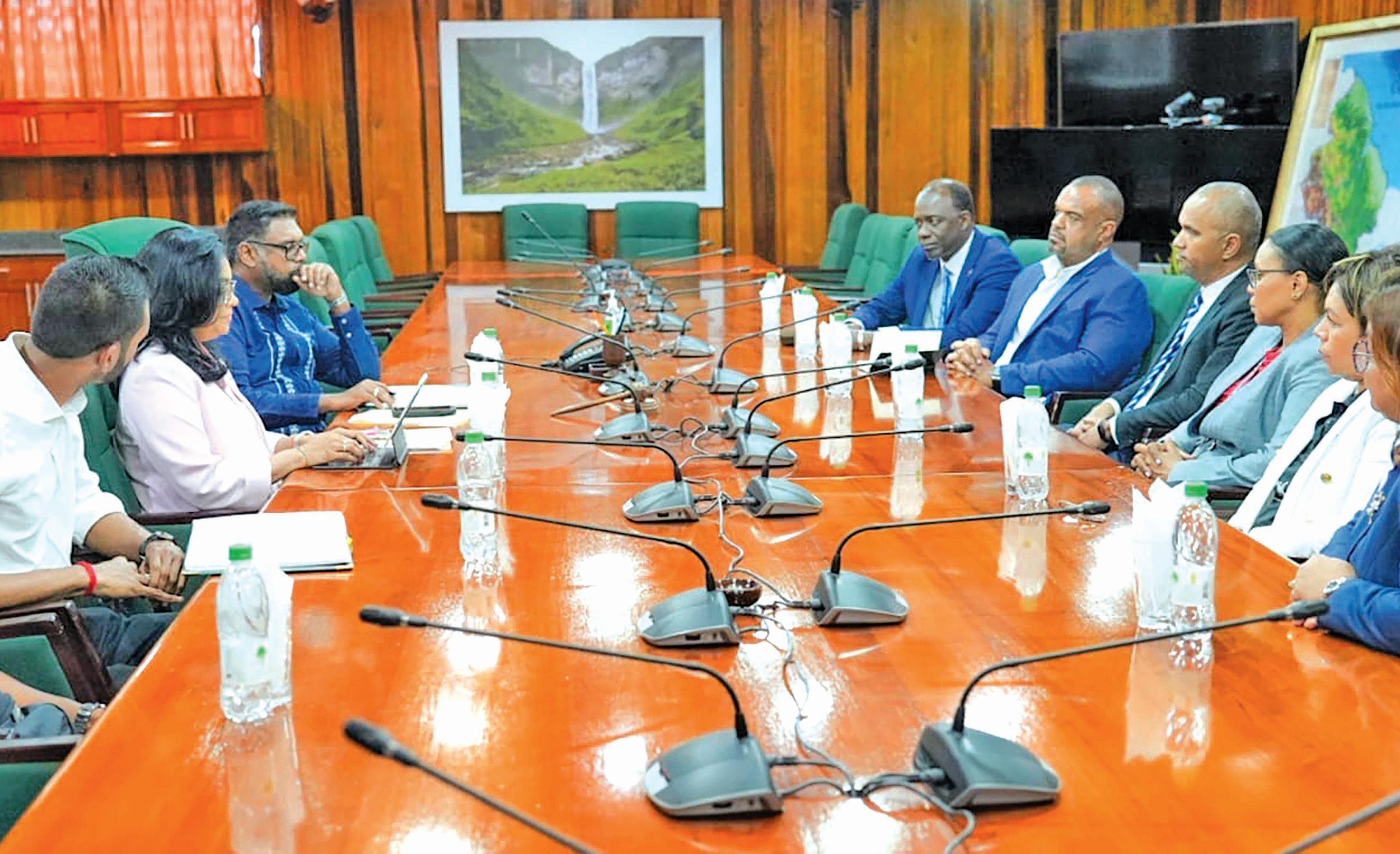
The NIP identified five broad sectors or clusters to serve as the engine to drive the national effort towards growth and development of the Jamaican economy. These are:
*Cluster 1: tourism, entertainment, sports
*Cluster 2: shipping and berthing, telecommunications, information technology
*Cluster 3: agro-processing, fresh produce, natural fibres, horticulture, marine products
*Cluster 4: apparel, other light manufacturing
*Cluster 5: minerals, caustic soda, chemicals, ceramics
Except for agriculture, Jamaica is characterised by sectors, not industries. There is a reason why in years when agriculture performs badly, the economy performs badly as a whole. Agriculture is an integrated economic activity from farm to market and includes agro-processing to produce value-added products. Jamaica and Jamaicans control much of the points along the value chain.
With recent efforts at backward and forward integration through the Tourism Linkages Network, led by Edmund Bartlett in the public sector and Adam Stewart in
the Private Sector, tourism is fast entering that realm. Although not typically listed among export products, it earns over 50 per cent of the country's foreign exchange, and directly and indirectly provides about one-fourth of all jobs.
Other people and countries benefit more than we do from the wealth-creating activities at which we are among the best in the world. They see more economic value and consequently make more strategic policies and investments in these areas while we are content with accepting trophies and medals. While a few talented individuals may garner wealth for themselves and their families, the impact on the country's GDP, which causes all boats to rise, is almost negligible.
Two examples are sports and culture. In neither case does Jamaica meaningfully participate in the multi-trillion-US dollar integrated global creative industry.
In the age of global competition, countries must compete like companies do. Only industries can help a country to do that. (Jamaica Observer)
(Dr Henley Morgan is founder and executive chairman of the Trench Town-based Social Enterprise, Agency for Inner-city Renewal and author of “My Trench Town Journey — Lessons in Social Entrepreneurship and Community Transformation for Policy Makers, Development Leaders, and Practitioners”. Send comments to Jamaica Observer or hmorgan@cwjamaica. com.)
Dear Editor,
Since my last letter, published in your letter column under the title “Speed bump can cause serious harm”, I haven’t seen any movement from those who are responsible for hurting this country in the name of road development. In fact, I have seen speed bumps being placed in greater numbers everywhere.
Every living day, I continued to witness incidents of hurt and harm caused by speed bumps to people and their properties. Last week, the egg van broke 17 trays of eggs. Half the number of blocks on a horse cart fell off while the cart was attempting to manoeuvre over a bump. An elderly man wobbled and fell just as he hopped over another bump. A young lady complained of losing her firstborn after the taxi in which she was travelling crashed over a speed bump and flung her into the front seat.
Editor, I continue to do more research, and have accumulated more data, because it is my conviction that whoever owns the idea to implement such a dangerous feature to our country’s road develop-
ment was badly advised, or is simply reckless with the wellbeing of this nation. My research has shown that our country may have accumulated approximately 55,000 speed bumps and counting.
Nowhere in the world did I find road development exposed its citizen to such danger.
As you embark on a journey through our streets, you sometimes encounter a speed bump every 30 seconds. Does anyone care what happens to our elderly, whose bones are already fragile, and who are most likely in pain?
The food in our stomachs isn’t allowed to settle, and this sometimes causes our stomachs to be upset after a journey. For years we have endured potholed roads. Today, speed bumps are everywhere, and our roads are no better than the potholes. It has cost me $500,000 EXTRA every year to upkeep my vehicle. I spent $120,000 on four shocks, ball joints, spring-bushing, and other related wheel components. It has also cost me one EXTRA gallon of diesel ($1250.00) every day for 300 working days,
amounting to $375,000 yearly. If 20,000 out of the 30,000 registered vehicles on the road are subjected to the same harassment, this could see a whopping $9.9 billion being lost by motorists yearly. This could have serious economic implications.
While the whole world is looking for fuel and energy efficiency, Guyana, in the name of road development, is shooting itself in the foot.
Recent information from the Madia dorm fire revealed that the fire tender had to hop about 50 times before it reached the fire site. This had hindered the fire engine’s rescue efforts by at least 30 minutes or more. Twenty lives were lost. Speed bumps have contributed to this loss. In any rescue operation, every second counts.
A similar occurrence happened in the Mahaica fire in which 2 children perished. A fireman admitted in a conversation that speed bumps have been a big challenge, and are partly responsible for most of the recent failures by the Guyana Fire Service. Every Guyanese must be concerned, and especially those who may
Dear Editor, Dr Janette Bulkan, an eccentric environmental activist, argued recently that the Government engaged in a fraudulent transaction in respect to the sale of carbon credits. She is alleging that the proper legal approval for same was not obtained from the Village Councils.
Readers would recall that this author challenged the environmentalist’s contentions in letters to the editor dated July 4th and 10th 2023.
In one of her recent letters, the environmentalist made a complete 360-degree turn in her contentions when notable facts were presented to her by this author in relation to the subject of contention. Her argument radically shifted from “the government engaged in a fraudulent transaction” to “the National Toshaos’ Council cannot usurp the powers of an Amerindian Village”. This 360-degree turn suggests that the environmentalist does not appreciate the facts on the issue, such that it is the Indigenous communities that stand to benefit in a tangible manner; and accept that this in and of itself is a positive development.
Pursuant to the Amerindian Act (2006), section 20 states that:
A Toshao -
(a) Is a member and Chairman of a Village Council;

(b) Is a member of the National Toshaos Council;
(c) Is responsible for ensuring good governance, including accountability and
transparency within the Village Council; and
(d) Is responsible for keeping peace and order in the Village.
The Toshaos are elected leaders of the villages, and are entrusted with the power to act on behalf of the village following the approval and/or agreement of the villagers. The Government of Guyana sought the explicit approval and/or support of the National Toshaos Council (NTC), inter alia, a resolution by the NTC endorsing the LCDS 2030, inclusive of all its elements. Additionally, the Government and the Chair of the Toshaos emphasized the need for Toshaos to stay involved as implementation of the LCDS moves ahead.
Moreover, it appears that the environmentalist activist failed to appreciate and recognize an important fact: that is, her argumentation thus far questions the legality of the procedure in which the Government proceeded with the LCDS.
However, the fact is that the Government has gone above and beyond the bare minimum legal requirement of a box-ticking exercise for an explicit legal approval from the Village Councils to one in which their wholesome involvement was sought in shaping the LCDS and involvement in its implementation. So, with this background in mind, the question of legality is a non-issue and an irrelevant, unsubstantiated argument, in my humble and respectful view.
It is not unreasonable
live 100/200 speed bumps away from any of our country’s emergency services.
I was in conversation with a medical doctor from the US, and the doctor expressed shock and horror that 55,000-speed bumps were in a small country like Guyana. He explained that there are differences between speed humps and speed bumps; one is gradual and the other is abrupt. He also warned that the volume of hopping citizens endure daily could overwhelm our medical system with serious back and spinal injuries in a few years.
Editor, it is no secret that we have a very serious problem of reckless driving on the road. This problem originated from years of corruption in the Guyana Police Force. More than half the so-called drivers on the road never sat one day in a driving class.
Every conversation on driving at the street corners reveals that a driver’s licence could be had for a price of $140k/$160k. Don’t tell me the Government and all the Opposition Parliamentarians don’t know of this. Nothing has ever been done over the
years to reform the outdated Traffic Department of the Guyana Police Force. The madness we are witnessing on our roads are symptoms of a disease that was left to fester for too long. I think all of us would agree that the Traffic Department has failed miserably. It has failed not because there are no hard-working personnel trying in difficult circumstances. It has failed due to not being armed with modern technology and advanced training to deal with the large volume of traffic in our country today.
You cannot use speed bumps to achieve what the law and law enforcement are mandated to achieve. It will always be absolutely necessary for certain categories of vehicles -- such as fire engines, Police patrols, and ambulances -- to move quickly in the execution of their duties. Subjecting them to speed bumps renders their roles useless.
Let me say a competent driver would always be a self-regulated person who upholds the law. Anyone who fails to possess these qualities has no right to hold a driver’s
licence. The President promised to create 50,000 jobs. Here is an opportunity to create or add 10,000 traffic wardens with speed guns and ticket books in every corner of this country.
There are several alternatives to speed bumps, and they are safe, effective, and economically viable. Now is the time to introduce new regulations, hefty fines and revocation of licences for reckless traffic violations. Those convicted of causing death by dangerous driving should be given lengthy jail sentences. Speed bumps should never be used to replace or compensate for the failure of the Traffic Department. It is time for the President of Guyana to act, and initiate a series of actions to bring the road insanity to an end. Speed bumps have created a double whammy for the economic wellbeing and health and safety of people in this country. It has no place in a well-managed society, where the rule of law is properly administered.
Yours sincerely,
C Woolfordto presume, henceforth, that Dr. Bulkan’s contentions are now even more suspicious and questionable in terms of her underlying modus operandi. As demonstrated in her latest response to the undersigned, when challenged, the learned professor made a radical 360-degree turn in her argumentation: from the Government acting fraudulently to questioning the legality of the NTC’s involvement in the process, which is a completely different matter, albeit a baseless case.
To my mind, her new contention is now a question of legal technicality, rather than the legality of the procedure employed, based on her previous substantive arguments. To this end, the environmentalist activist said the NTC did not provide legal consent, which could only be obtained from each village separately. But, as I previously pointed out, the Government went far beyond merely obtaining legal consent to the point of inclusivity, wherein the Village Councils were involved in the crafting of the LCDS, and were encouraged to remain involved in its implementation.
In closing, I do hope the readers, particularly the Indigenous peoples of our country, recognize the learned professor’s inconsistency on this matter now that she has been challenged. Effectively, the professor has cleverly demonstrated that her modus operandi is questionable.
Yours respectfully, Joel Bhagwandin
Dear Editor, There was, on Channel News Asia, a recent documentary based on Singapore and covering the serious dangers of using mercury in gold mining. It was very saddening to see how the smaller gold miners and their families were seriously affected by this highly toxic metal.
The recent tragedy at the Guyana Geology and Mines Commission (GGMC) and the concerns uncovered with mercury being in the blood of scores of our workers should have been a wake-up call for all of us: that we must find another way to safely extract the gold needed to support the development of the economy.
It is said that mercury eventually enters the food production cycle, and does not break down in the environment, but instead enters the water cycle when it is burned and becomes a gas. It is therefore extremely important that we move towards banning its use in the gold mining industry. There are many healthier alternatives, from panning to magnets, that can be implemented to effectively protect miners and extract the gold. The safety of our citizens must become and remain the top priority for our nation.
Our Amerindian brothers and sisters are at the highest risk of being exposed to the harmful effects of this poison being used to mine the land for gold. The country is already being enriched by the extraction of oil, and we should not become greedy to the detriment of ourselves and our people. The pace of gold extraction should be in sync with the safe methods of mining. There is no longer an ur-
gent economic gap that needs to be filled by the sale of gold.
The country can also afford to provide a monetary incentive to miners, to ensure they do not suffer any economic hardship due to the transition to safer mining practices which would allow them to safeguard their and their families’ health while earning an honest living in a safe environment.
CRG looks forward to the current Ali Administration
implementing, in the gold mining industry, the necessary regulations and reforms that would ban the use of mercury in the industry, improve the required safe work practices, and provide the financial package and/or jobs needed for the miners to not suffer any economic setbacks as we transition to a safer gold mining industry.
With concern, Jamil Changlee
Before you begin to solve equations by multiplication and subtraction, you should review some interesting things about numbers. Division is the “opposite” of multiplication. Multiplication is the “opposite” of division. If you multiply an original number by a second number, and then divide the product by a second number, you are left with the original number. For example: 4 x 6 ÷ 6 = 4. If you divide an original number by a second number, and then multiply the quotient by a second number, you are left with the original number. For example: 4 ÷ 2 x 2 = 4. That works because division is the same as multiplying by a reciprocal.






• When you are out on your Weather Walk, take time to look up at the sky (but not directly at the sun)! Especially look carefully at clouds, sketch them, and describe them in your Weather Journals. As you sketch, understand that you don’t ever have to draw beautiful “perfect” pictures — the Sky Sketch is to document your observations and draw what your think is important to remember.
• Based on observation and sketch, write predictions about what the sky will look like the next day.


• Look for changes in your Sky Sketches and recurring patterns, and note these in your Weather Journals.

You know that if you have a fraction with the same number in the numerator and denominator, the fraction is equal to 1. So (You do not even need to know the value of x!)




In an equation, you need to treat both sides the same way. Whatever you do to one side, you must also do to the other side.

As the world celebrates World Population Day 2023, President Dr Irfaan Ali has assured that advances are being made by the Government in a number of sectors while they push to reduce gender inequality.
July 11 marks World Population Day, a day that sets out to raise awareness of global population issues… particularly vulnerable populations.
According to President Ali, women and girls are among the most vulnerable in populations and the People’s Progressive Party/ Civic (PPP/C) Government is making a concerted effort to protect and empower them.
“Gender disparities pose obstacles to women and girls realising their full potential. This is why
my Government is making a concerted effort to reduce gender inequality in education, employment, health, political representation and decision-making,” the President said.
“Guyana subscribes to equal opportunities for women and girls. We believe that by dismantling obstacles which stand in the way of female empowerment, we can unleash their full potential, thereby contributing to the well-being of society.”
According to President Ali, education remains a vital area of focus when it comes to reducing inequalities. He said that this is why the Government launched initiatives such as the Guyana Online Academy of Learning (GOAL).
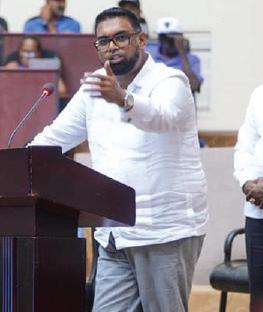
The President revealed that GOAL has become a potent tool in providing

women with the knowledge and skills, backed by certification, to allow them to grasp the increasing opportunities generated by Guyana’s economic transformation.
“Guyana also is working assiduously to improve healthcare, including maternal and reproductive healthcare. We have declared a policy of zero tolerance against domestic violence. As we know, women are the principal victims of these crimes,” the President further said.
“The Government of Guyana is also empowering women economically. We have an initiative to encourage women and youth in agriculture, thus opening income opportunities for our women. Also, we are catalysing female entrepreneurship to boost female participation in business.”
Meanwhile, President Ali noted that the theme for this year’s World Population Day, “Unleashing the power of gender equality: “Uplifting the voices of women and girls to unlock our world’s infinite possibilities”, is an important reminder of the continuing need to address gender inequality.
Pointing out that the world’s population continues to rapidly increase and is projected to surpass 8.5 billion by the end of this decade, the President noted the urgency of making sure women and girls, historically the victims of marginalisation, are provided with better opportunities for economic, political, professional and social empowerment. He made it clear that Guyana will continue to do its part.
Former Chief Executive Officer
(CEO) of the National Industrial and Commercial Investments Limited (NICIL), Winston Brassington, has secured further wins in his libel suits against the National Media & Publishing Co. Limited, publishers of the Kaieteur News, and against Adam Harris, the then Editor-in-Chief of the Kaieteur News.
According to the court documents, High Court Judge Fidela CorbinLincoln weighed all the “aggravating and mitigating factors” in making her decision, and awarded damages in the sum of $900,000 for each of the actions. She also awarded costs in the sum of $150,000 in one of the actions and $100,000 in each of the other three claims, which allege that Kaieteur News committed libel against Brassington in a series of publications made between February and April 2014.
“The plaintiff’s evidence is that he was made the subject of ridicule and suspicion as a result of this and other publications, and that his friends would telephone him about the publications. The plaintiff gave evidence with respect to what his children reported to him was allegedly being said by their school mates and teachers. There is no evidence that the plaintiff suffered psychological trauma, mental anguish, or social loss as a
result of the publication,” the court documents state.

According to the ruling, the alleged acts of libel committed by Kaieteur News are serious, as they impute “some form of criminality and corruption”. There is also no evidence that the defendants apologized or issued a retraction for the libel. According to the Judge, Brassington stated that the defendants did not communicate with him prior to the publication, or requested a comment or response to the accusations.

“In determining the quantum of damages, I have taken all the facts of these cases into consideration, and all the circumstances, including that: (a) the plaintiff filed several actions contemporaneously, with these actions based on publications by the defendants which occurred within days, weeks and months of these publications; (b) in those ac-
tions, the plaintiff, relying on essentially the same evidence as he does in these actions, recovered damages in respect of defamatory words, the effect of which was to impute dishonesty and criminality to the Plaintiff.”
During the court case, the lawyer for Kaieteur News publisher Glenn Lall had argued that Brassington had already received compensation for previous libel suits filed against Kaieteur News, and the court should not award further damages. However, Timothy Jonas, SC., who represented Brassington, urged the court to consider the damage done to Brassington’s reputation by the publications.
According to the ruling, however, previous awards for damages in other libel cases Brassington had filed act as a form of mitigation of damages. The Judge noted that the ob -
The breaking news was stark yesterday, as Pres Irfaan Ali announced the passing of Ashton Chase. “His death represents an incalculable loss to our nation. His name and contributions will forever be etched in our country’s political, labour and legal history. He made an exceptional contribution to Guyana’s nationalist struggle and political history, and was the last surviving member of the Political Affairs Committee (PAC) established in 1946. He was among our finest legal minds, and was a pillar of our country’s early trade union activism, authoring the most authoritative work on our trade union history.” Wow!!
jective of awarding damages in defamation is to compensate, rather than penalise.


“Weighing all the aggravating and mitigating factors, and having regard to the purpose of an award of damages, the awards already made, and the fact that libel is actionable per se, I assess damages in each action in the sum of $900,000. These claims do not fall under the Civil Procedure Rules 2016.”
In 2020, Brassington won his defamation cases against Kaieteur News and its former Editor-inChief over articles published. The High Court awarded him $18 million in damages, along with $220,000 in court costs.
During 2014, in its ‘Dem Boys Seh’ column, Kaieteur News, owned by Glen Lall, published several articles defaming Brassington, who is now the Head of Guyana’s Gasto-Energy Taskforce. (G3)
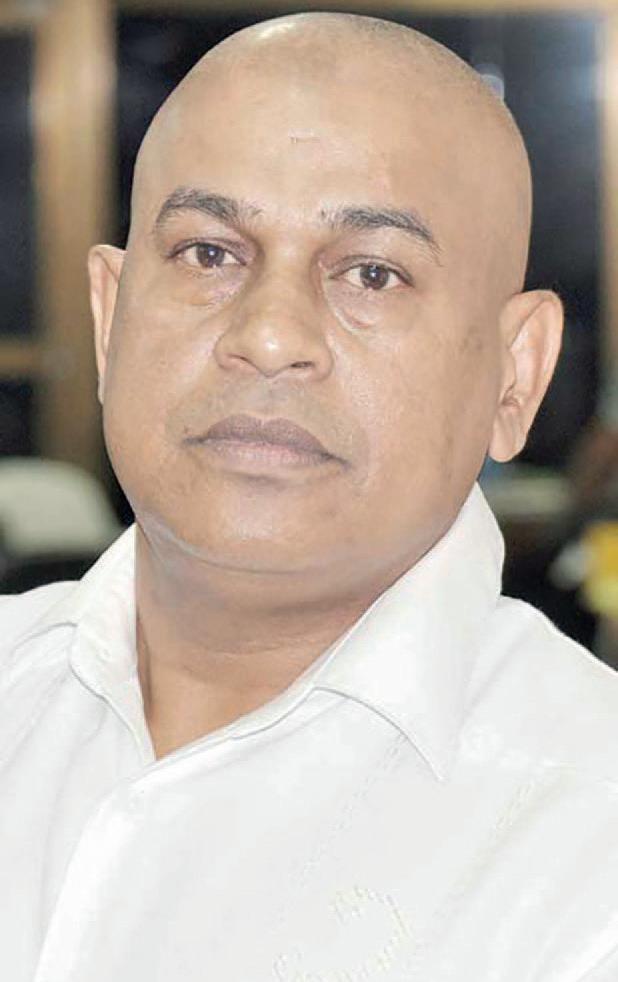
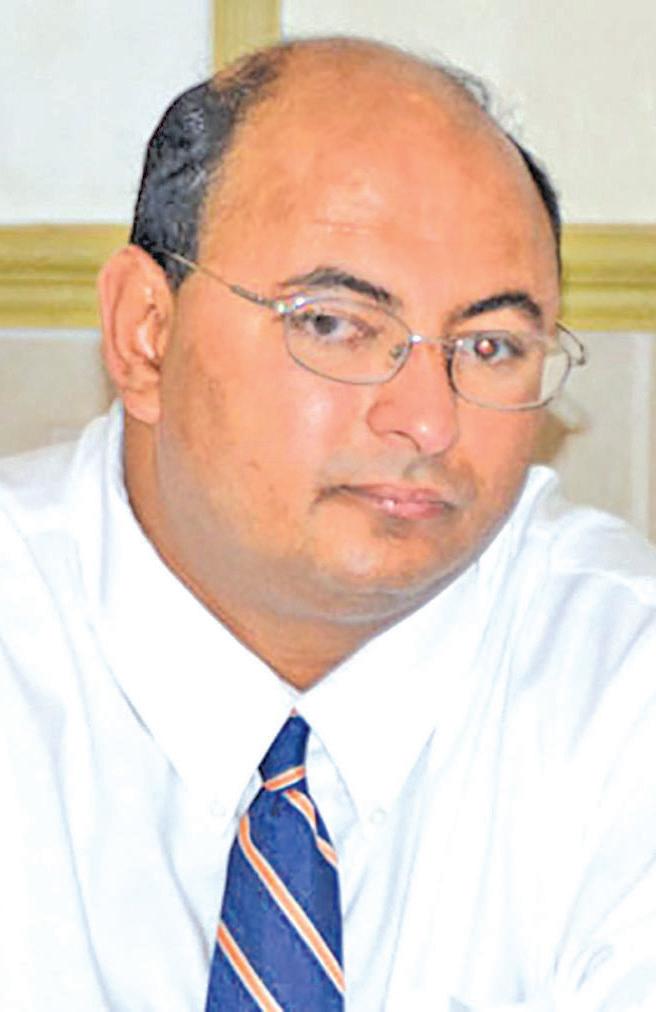
Born in 1926, Chase would’ve been only 20 when Cheddi Jagan, Janet Jagan, Jocelyn Hubbard and he founded the PAC, which began a series of talks and discussions that fired the imagination of the WWII generation, who’d been promised a new world. After all, weren’t the millions of deaths in WWII justified as necessary to “secure” democracy for the world?? Those were heady days for these youngsters – Jagan was only 27!! – who rejected the old, accommodationist, gradualist approach of the older generation of politicians. They were gonna storm the bastions of colonial power!!
After graduating from Alleyne’s High School, Chase did a correspondence course with Ruskin College in Oxford, England, but when the PPP was to be launched in 1950, he modestly stepped aside for Forbes Burnham, whom he felt was “brighter”. He would eventually proceed to London University, and enter the bar in the mid-fifties. This was after he was a Minister in the short-lived 1953 Government and during the same time that Burnham would split the nationalist movement – from which we’ve still not recovered!! Ahh…the ironies of fate!! If only this brilliant man wasn’t so modest!!
But we can see, from those days, the emphasis by the Creole Middle Class -which dominated politics then – on being “lettered” as necessary for political office. Your Eyewitness would’ve thought that the Burnham substitution for Chase would’ve cured the Guyanese people of that affliction – which Lloyd Best derided as “Doctor Politics”!! But we’re still infected, aren’t we?? Chase became the most noted labour lawyer – following in the footsteps of his grandmother, who was an official in Critchlow’s pioneering BGLU – and literally wrote the book on the subject!!
He also pleaded successfully in the Courts in the historic GuySuCo v Teemal (1983) case, when Burnham attempted to deny a salary increase - agreed to with the TUC - for GuySuCo workers. Burnham later passed legislation to overturn the decision – but for the first and only time, the Courts ruled the legislation unconstitutional!!
All in all, today’s youths should be informed of the great deeds modest men can achieve for their country. Bombast isn’t necessary for leadership!! Rest in peace, Mr Chase!!
Cash crops are simply crops produced directly for the market. That’s all!! And our tradition with cash crops goes all the way back to slavery, when slaves were allowed to plant greens and ground provisions and sell at the Sunday markets. So, it’s a myth to think slaves had no experience with commerce. The problem, though, was that their efforts were limited to family labour, and, as such, were quite fragmented.
Today, we hear about “food security” and our commitment to fulfil Caricom’s “25 by 25” – reduce its US$6 BILLION food bill 25% by 2025. We gotta realize we’ll have to take a whole new approach to satisfying such a humungous market!! The first thing we gotta do is massively increase our scale of production of the identified crops. We can do this in two ways – through launching plantations, like the colonials did for producing coffee, cotton and sugar cane back in the day; or coordinating private farmers to produce the crops. Ain’t gonna happen spontaneously!!
Your Eyewitness noted that Mia Mottley just received Venezuela’s highest honour from Maduro. But is the AgriFood Sovereignty Agreement signed by her Minister of Foreign Affairs, Kerrie Symmonds, and Ambassador to Caricom, David Comissiong, tied to Caricom’s “25 by 25”??
Government has also committed $50 million towards establishing a breeder programme, so hatching eggs can be produced right here in Guyana.
“We have a private farmer who has already started the breeder project. In this year’s Budget, with the Ministry of Agriculture, we have $50 million budgeted to start the breeder programme, so that we can produce our own hatching eggs [and] bring down the costs of hatching eggs,” Mustapha said during the symposium. “Rather than importing it into the country, we can produce it right in Guyana.”
As the Government continues to enhance its food production and diversify its current meat output, President Dr Irfaan Ali has disclosed plans to co-invest in both sausage and protein plants.
“In the forward planning, I am now proposing that we have some co-investment in a sausage plant, to meet the local and regional demand; a protein plant for aquaculture, because when we ramp up production, we’ll have more waste products that we can use for the production of
protein for aquaculture; and the chicken nugget facility that comes with the sausage plant,” Ali has said.
The President made this remark on Friday, during a poultry symposium hosted by the Guyana Livestock Development Authority (GLDA) in which he proposed rebuilding the poultry sector to become more sustainable, viable, and profitable. He noted that opportunities exist to branch out into both regional and international markets.
“We create, through
the Guyana Marketing Corporation, a brand that will now go through the region, because we have specific trade arrangements. We have low-hanging opportunities in other large regional markets like Cuba and Dominican Republic. And then, of course, we have emerging potential markets in the United States (US),” Ali has said.


Meanwhile, in another initiative to expand the country’s poultry industry, Agriculture Minister Zulfikar Mustapha noted that the
Guyana currently imports about 52 million eggs each year at the cost of some $350 million. This initiative aims to ensure that hatching eggs are produced sustainably, both locally and eventually for the export market.
The Minister remarked that this breeder programme is one of several Governmentled plans to position Guyana as a net exporter of poultry.
“The Government has been providing incentives in priority areas of agro-processing: coconut, corn and soya beans; beef and, more importantly, poultry production. We are looking forward
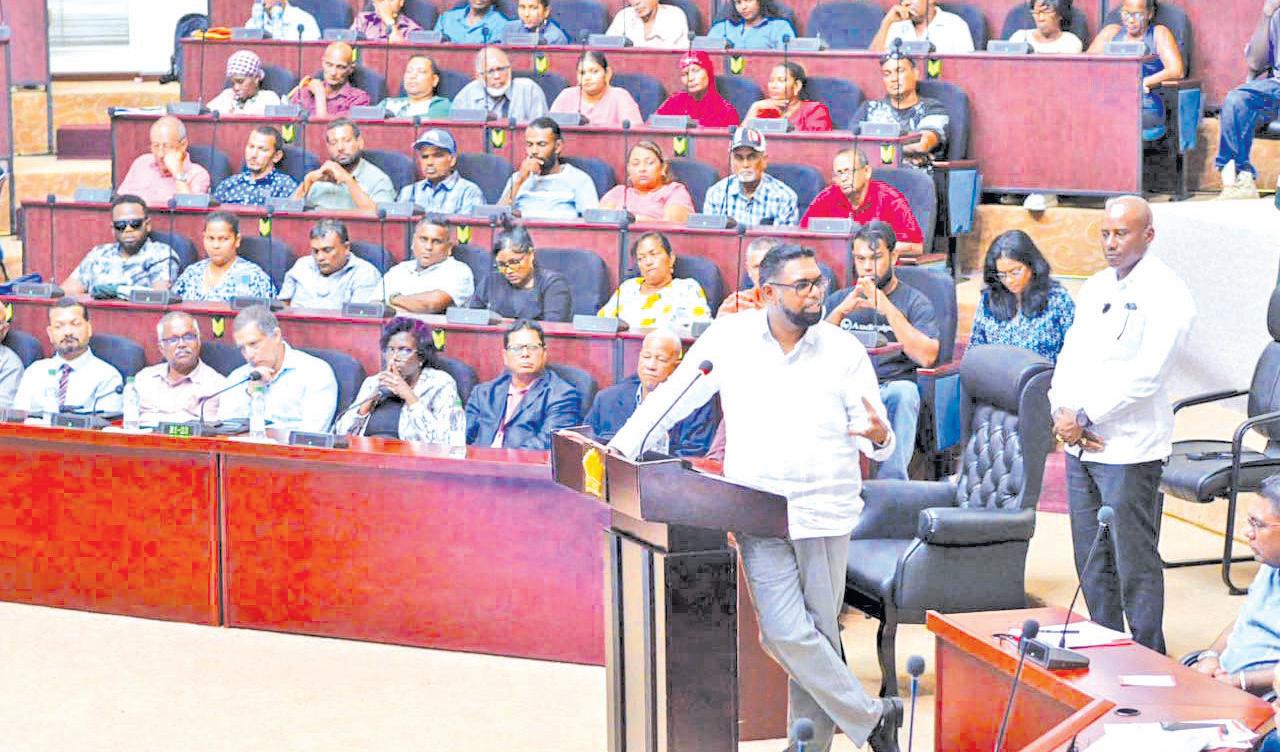
to being a net exporter of poultry,” Mustapha has said. This is in keeping with Guyana’s goal to reduce the Caribbean Community’s (Caricom’s) food import bill by 25 per cent by 2025.
According to Guyana Poultry Producers Association (GPPA) Chairman David Fernandes, the poultry industry is the largest non-traditional sector in the country, with 80 per cent of meat consumed by Guyanese being poultry.
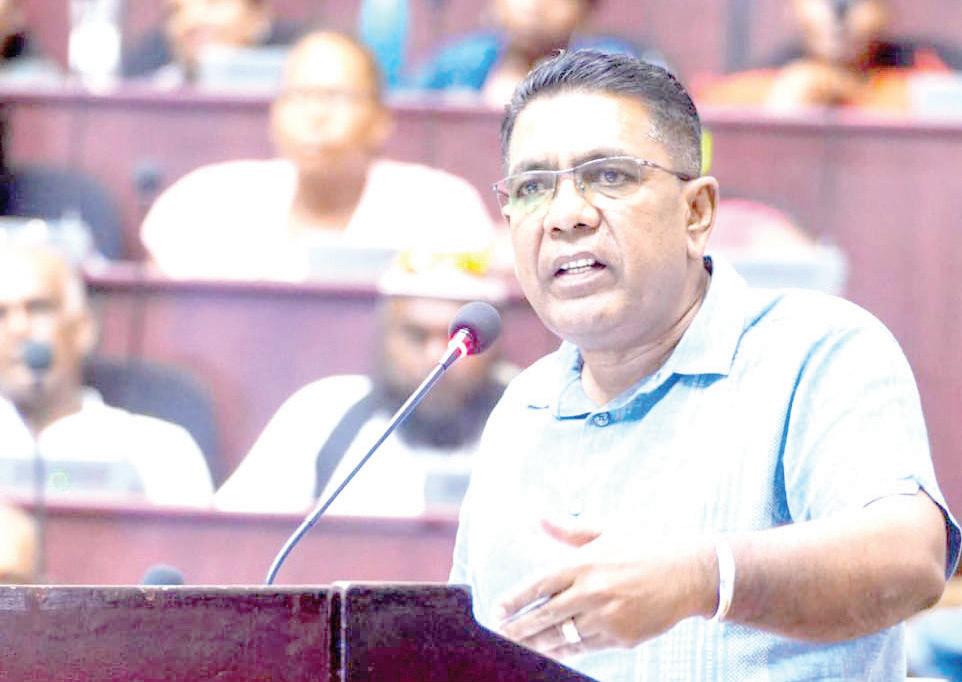
With six large operations and thousands of small and medium-scale farmers specializing in various types of poultry, the industry employs and supports over
18,000 persons. Given the sector’s significant contribution to Guyana’s food security and economic development, the President has signalled a need to enhance it to be one of the region’s leading poultry sectors.
As such, among a number of Government-led initiatives, the President has highlighted plans to increase cold storage facilities, provide small farmers with loans to aid their production, cover the costs of required vaccines, consider implementing a zoning system to better manage poultry, and produce corn and soya for feed production.
From the standpoint that Guyana today is ‘ripe with opportunities’ for investments, the local private sector was encouraged to consider the Inter-American Development Bank (IDB) as a mechanism for financing.
Senior Minister in the Office of the President with Responsibility for Finance, Dr Ashni Singh shared this position at the launch of the IDB Invest, Caribbean- Suriname and Guyana Edition Workshop, at the Marriott Hotel, as he highlighted the economic wave which is currently passing through the country.
The workshop falls under the “IDB Invest Caribbean Series,” and is
designed to match the local private sector needs with the IDB’s private sec-
tor in various areas including energy, modernisation of the agriculture sector, and strengthening the transportation system among others.
Singh underscored that IDB has facilitated transactions as small as US$5 million. While the standards may be higher, it will allow them to prepare for such environments.
“I would say to the private sector of Guyana, I urge you to consider the IDB Invest a viable option for raising financing. It might seem like the barriers to entry are a little high, a lot of standards and studies that you have to do…but the reality is in today’s world, even if you don’t meet those standards to raise financing with the IDB, if you want to do business with major companies around the world, chances are you are going to have to comply with those standards anyhow,” he urged.
Equally, he called on the IDB to work with the private sector in sharpening their abilities to do business in a modern world.
“I would urge the IDB Invest to work with as many Guyanese companies as you can to bring them up to a point where they’re able to access financing not only in the interest of concluding a
transaction but also in the interest of them being able to participate in the modern world.”
For a long time, the IDB has been the single source of development financing for Guyana and its public sector portfolio remains the same to date. Even in the pre-oil Guyana, Minister Singh said Government has been advocating for the IDB’s operations with the private sector to ramp up.
“Even before oil, we in Guyana realised the critical, indispensable role to be played by the private sector in any lasting economic growth and sustainable socioeconomic development. We have always viewed Government’s role as one where we provide the critical prerequisites to economic development and appropriate policies and legislative framework, critical infrastructure to facilitate private investment and job creation. But that environment, we have always expected would be responded to by the private sector,” he detailed.
According to the Minister, there are opportunities for growth and expansion in every single sector of economic endeavour. Oil has opened up doors in several areas which persons can capitalise on, such as logistics, hospitality, financial ser-
vices, supplies among others.
“There has never been a time as ripe as today for the private sector of Guyana to invest in good, bankable projects. It doesn’t matter what you’re doing. Today there are people buying a fleet of buses and taxis and getting a contract with ExxonMobil.”
The Guyanese economy has grown at an average of more than 40 per cent over the last three years. It is projected to grow at an average of 25 per cent over the next three to five years. And with this economic boom, Government has reiterated that Guyana is open for business.
Back in March, the Georgetown Chamber of Commerce and Industry (GCCI) had said that continued bureaucracy at commercial banks in making access to financing easily available was putting local businesses at risk of becoming unable to compete in Guyana’s oil and gas sector, as well as losing out on Government projects.
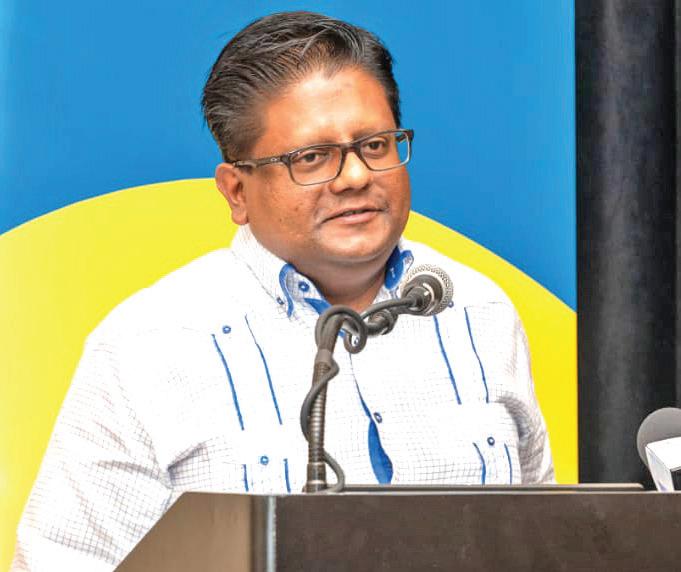
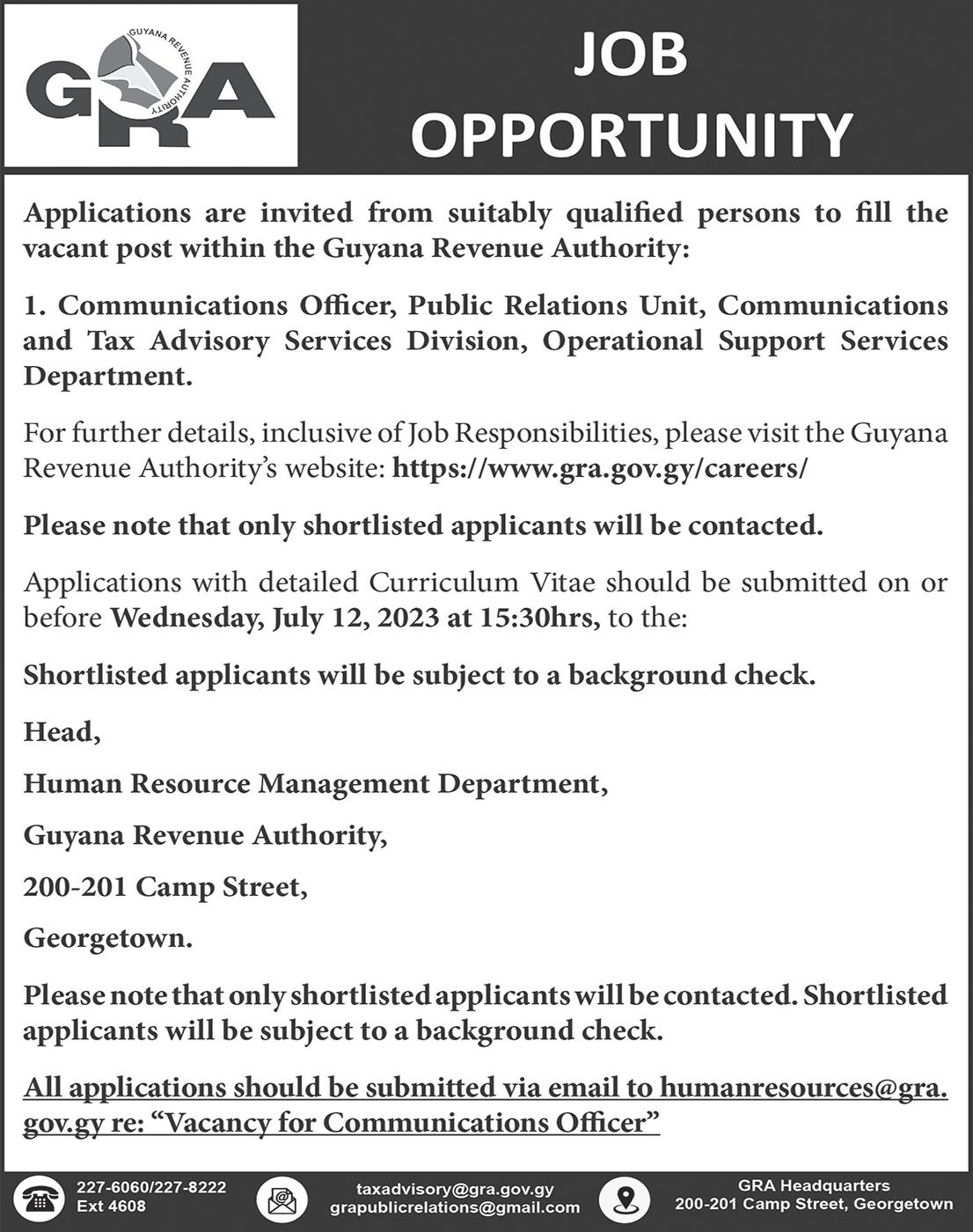
As such, the body had called on the local banks to be proactive and outline the hindrances – whether legislative, economic, social, or environmental –that are restricting better access to finance for the local private sector. (G12)
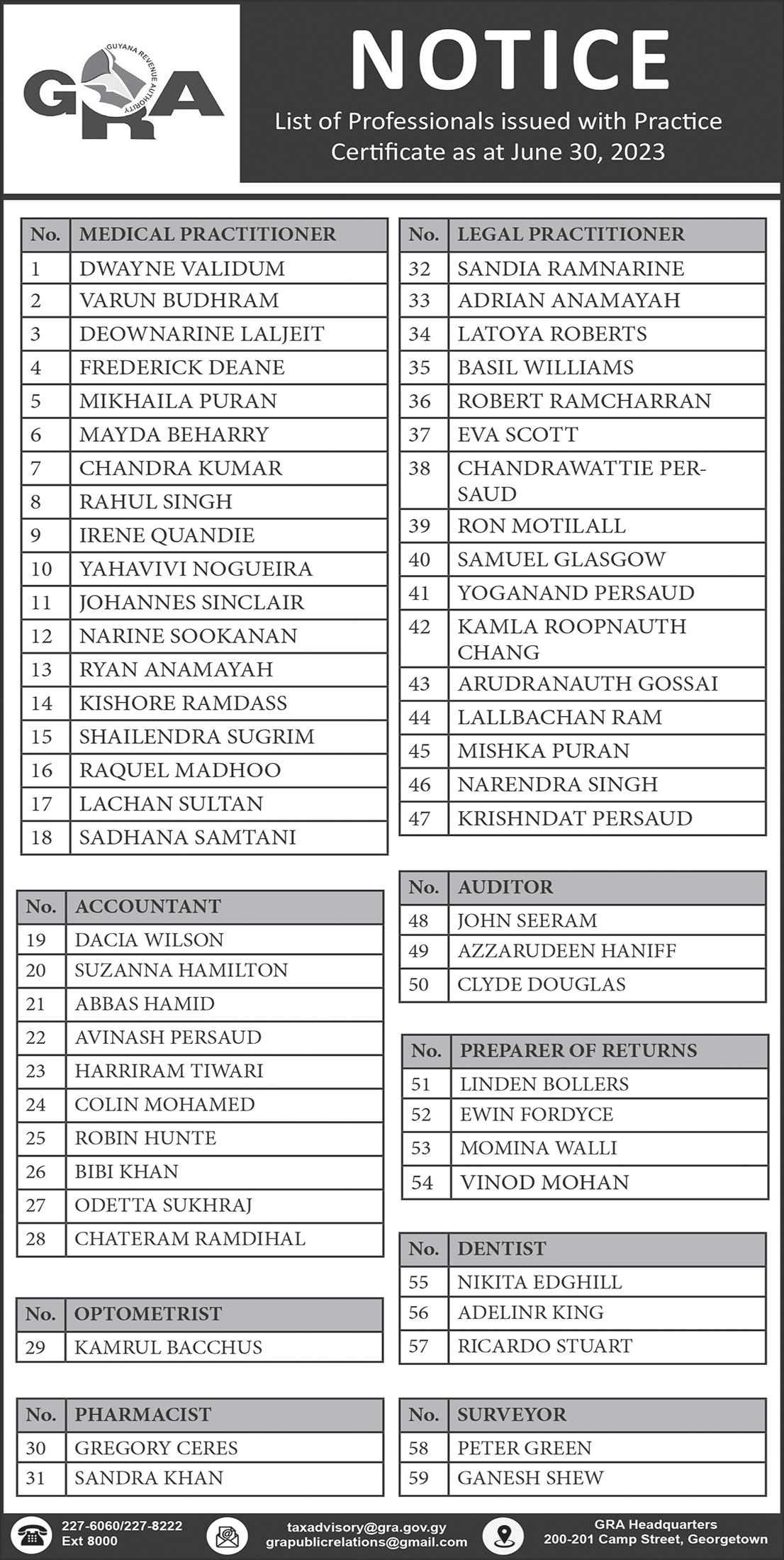

Parents who were unable to uplift the “Because We Care” cash grant during the scheduled distribution period will have a chance to do so on Thursday, July 13.
The Education Ministry has notified that the grants will be issued at the respective Departments of Education in Regions Two (Pomeroon-Supenaam), Three (Essequibo IslandsWest Demerara), East Bank and East Coast for Four (Demerara-Mahaica), Five (Mahaica Berbice), Six (East Berbice-Corentyne), Seven (Cuyuni-Mazaruni), Nine (Upper Takutu-Upper Essequibo) and 10 (Upper Demerara-Berbice). For Georgetown, the distribution will be done at the Queen’s College auditorium.
All grants are to be uplifted between 09:00h and 17:00h on the aforementioned date. The $40,000 cash grant sees children registered in nursery, primary, and secondary public and private schools receiving a $35,000 grant, together with $5000 for school uniforms and other supplies.
The grant can be uplifted by parents or guardians with a valid form of identification. It was reported on June 9, that 90 per cent of the grants were distributed across the country.
Any child attending a private or public school,

from the nursery level all the way up to the Caribbean Advanced Proficiency Examination (CAPE) level, is able to receive this grant.
Pupils entering nursery school this year must have been registered by April 14 to be eligible.
In 2021, Government reintroduced the cash grant distribution for school-aged children, as per its manifesto promise. The distributions at that time saw each child benefitting from $19,000 — $15,000 from the “Because We Care” grant and $4000 from their uniform vouchers.
In 2022, the Government increased the “Because We Care” cash grant amount from $15,000 to $25,000, and the uniform voucher from $4000 to $5000. This meant that each child went from receiving $19,000, to $30,000.
This year, more than 214,000 children were eligible to receive the grant. This equates to some $8.6 billion in disposable income being made available to families nationwide.
Education Minister Priya Manickchand had noted that the $40,000 cash grant comes as a promise made by the Irfaan-Ali-led Administration and added that before the end of the Government’s five-year tenure, the targeted distribution amount is $50,000 the least.

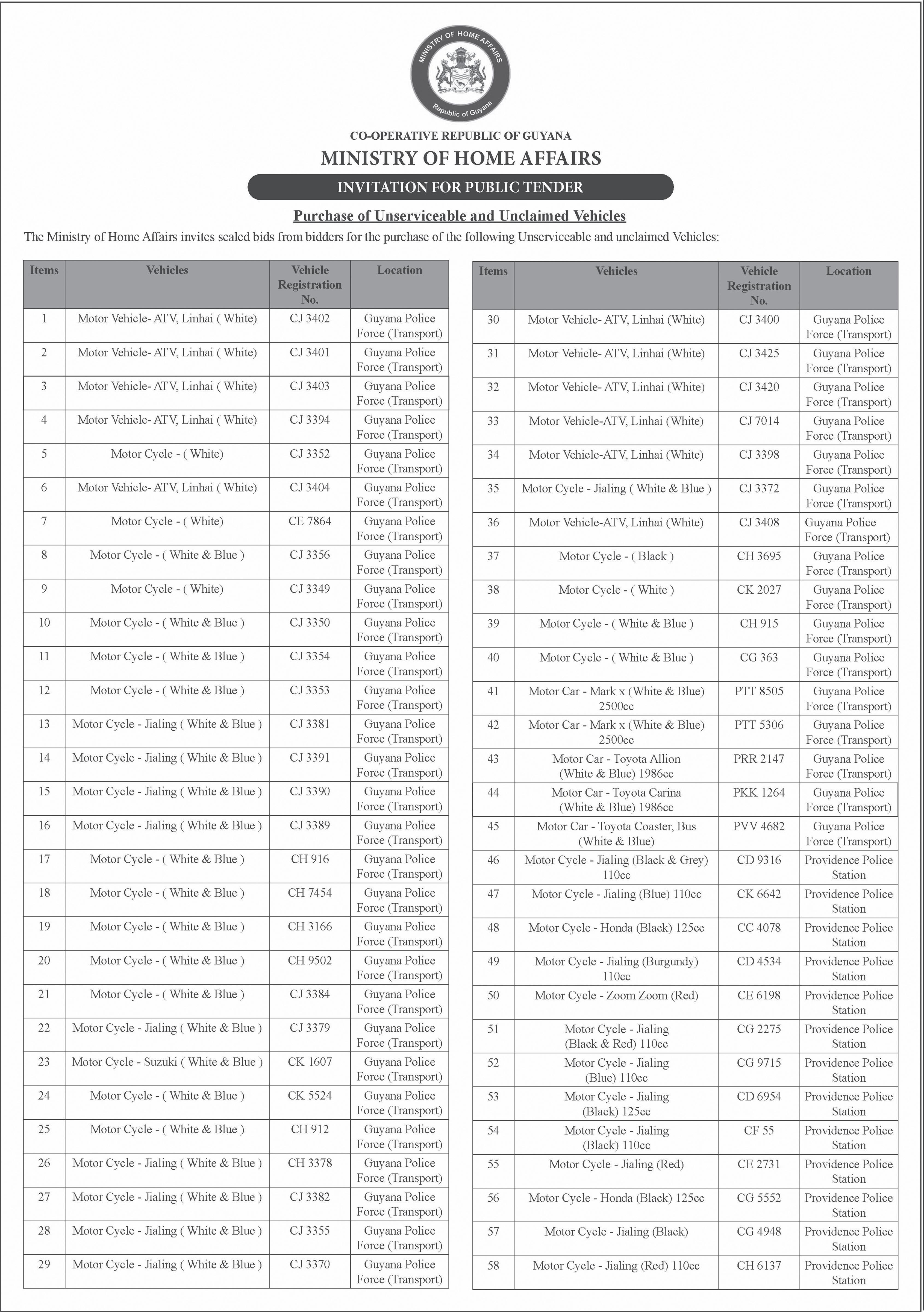
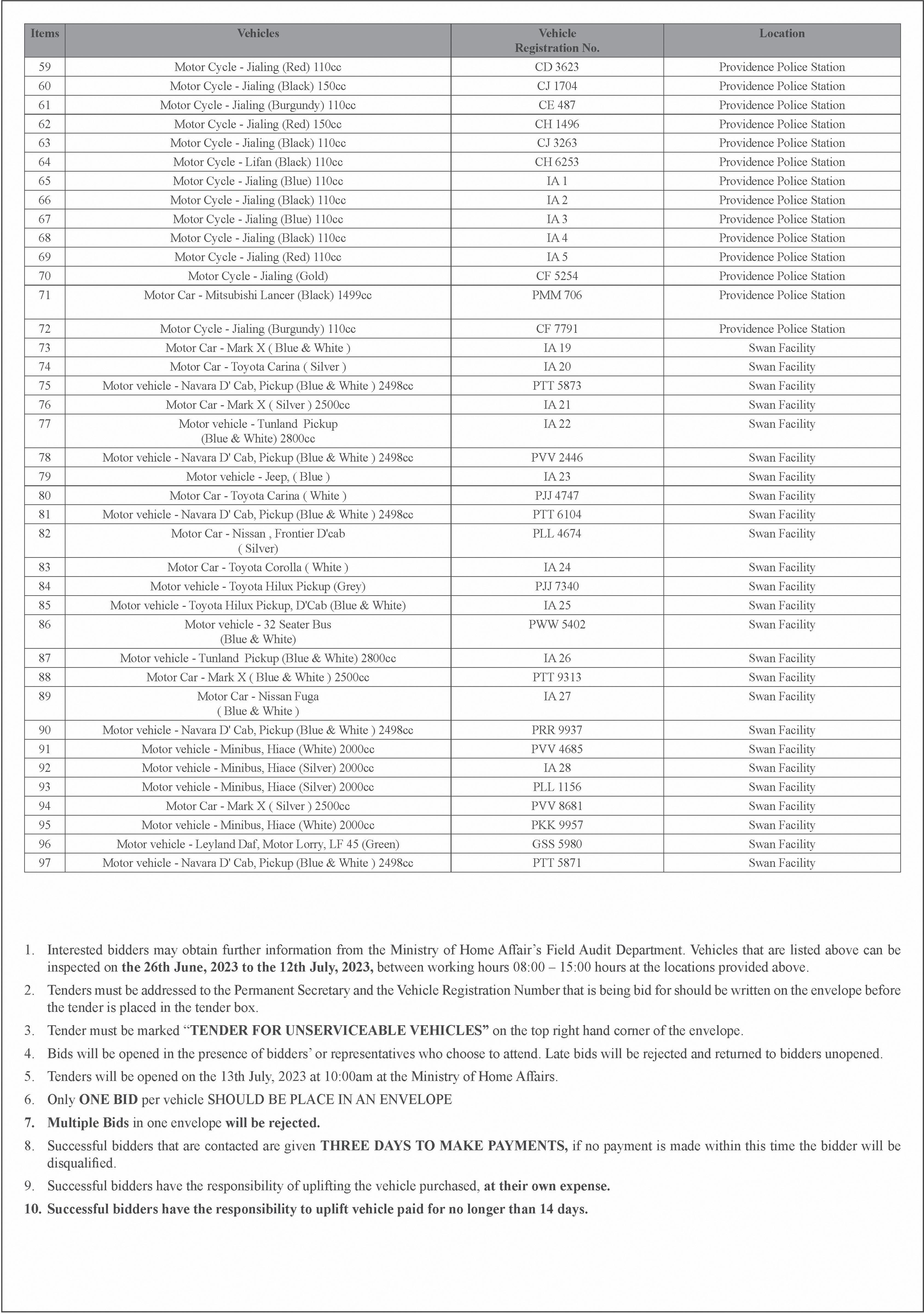
13 bridges between Mabura and Kurupakari, upgrading them from wooden to concrete structures.
As the first 32 bridges are slated for completion within the next four months, Edghill noted a level of dissatisfaction with the progress seen during his visit.
mended the work of some contractors in adhering to the contract stipulations and deadline, he stressed the need for all to complete their assigned lots in order for the Ministry to deliver on its promise to the beneficiaries.
Kurupukari and Lethem while later in December, contracts amounting to some $2.4 billion were signed to reconstruct the bridges between Kurupukari and Mabura.
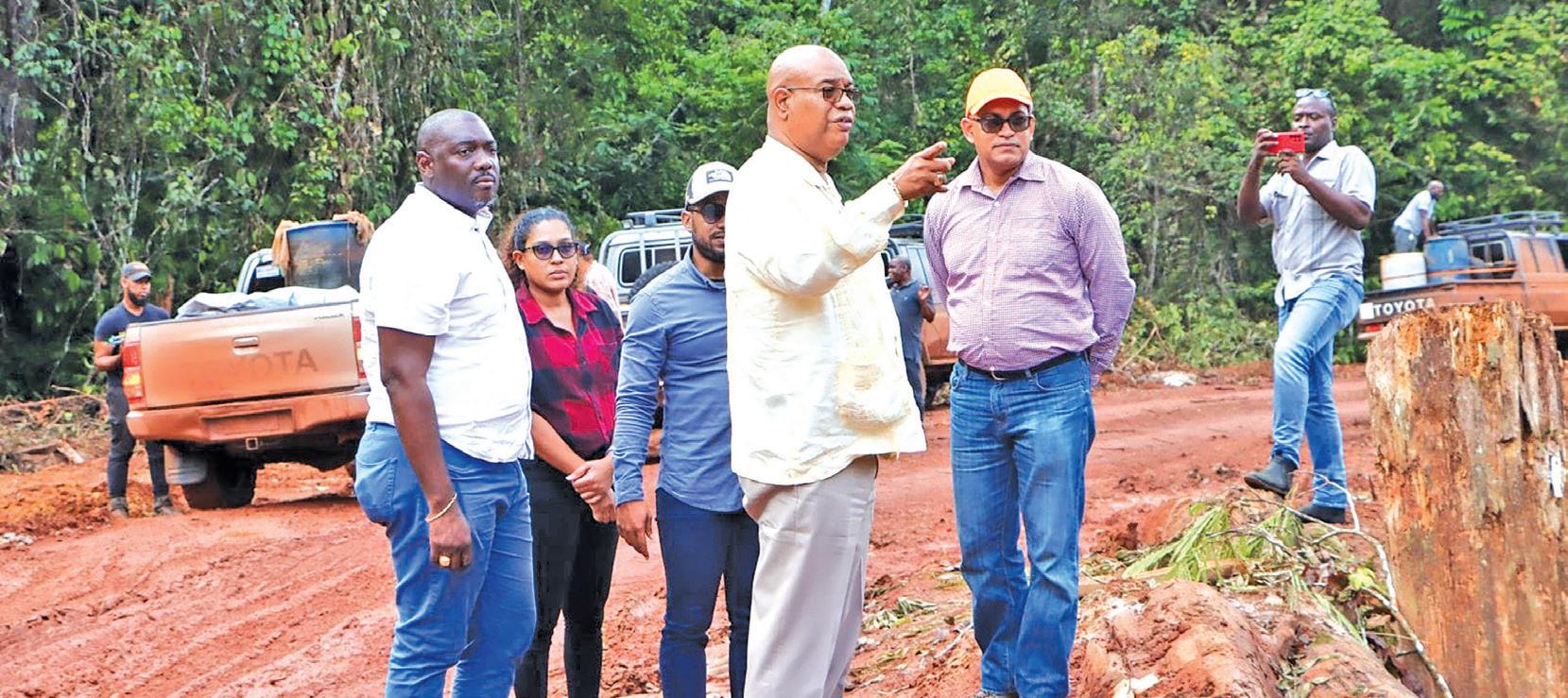
Public Works Minister Bishop Juan Edghill has warned contractors of a zero-tolerance policy for delayed and subpar
work during an inspection of a number of bridges slated for rehabilitation within Region Nine (Upper Takutu-Upper Essequibo),
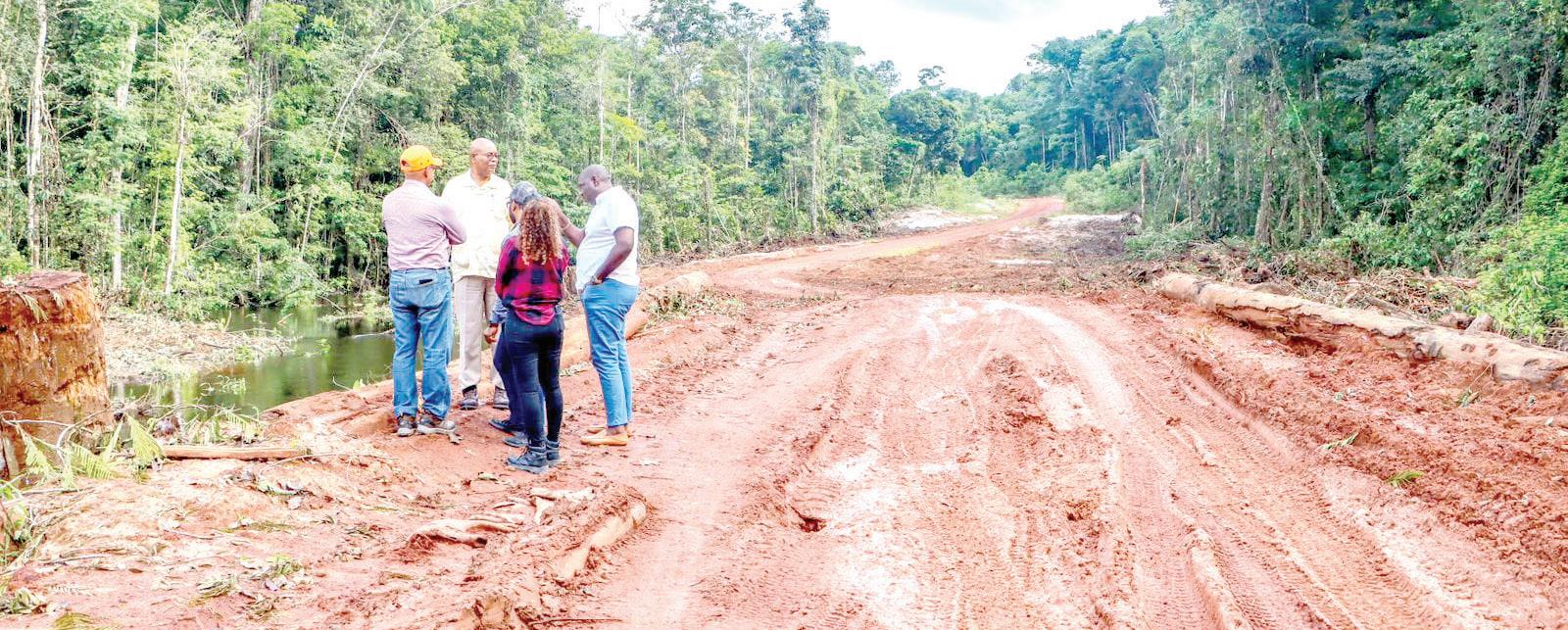


Last year, the Public Works Ministry signed over $5 billion in contracts to reconstruct 32 bridges between Kurupukari and Lethem and
“The contractor was not on site to meet me, neither were the workers on the site. It is highly disrespectful for a contractor to sign a contract with my Ministry…and they’re not on site. It seems some people want to do work at their time [but] mediocrity will not be condoned in any way,” Edghill said.
He remarked that the purpose of this inspection was to assess the pace and quality of
“There's no time at all that I will tolerate contractors showing disrespect or disregard to instructions and moving at their own pace,” Edghill said.
As such, he disclosed that clear instructions will be given to the contractors failing to meet expectations.
“[After reviewing] all of this with my engineers, clear instructions will be given to the contractors–either they follow it or they walk,” Edghill said.
Bridges are being rehabilitated in areas including Iwokrama, Surama, Carmudi, Massara Junction, Annai, Yakarinta, Gunip Landing, Point Ranch, Hunt Oil, and Pirata.
This bridge project forms part of the Government’s overarching plan to develop and upgrade the LindenLethem corridor, with the bridges aimed to link to the construction of the Linden to Mabura road.
The first 10km stretch of roadway under the Linden to
work and pinpoint areas that need to be readjusted.
While the Minister com-
Last April, $3.19 billion in contracts were signed to upgrade the 32 bridges between
Mabura Hill Road Project is expected to be completed by September.
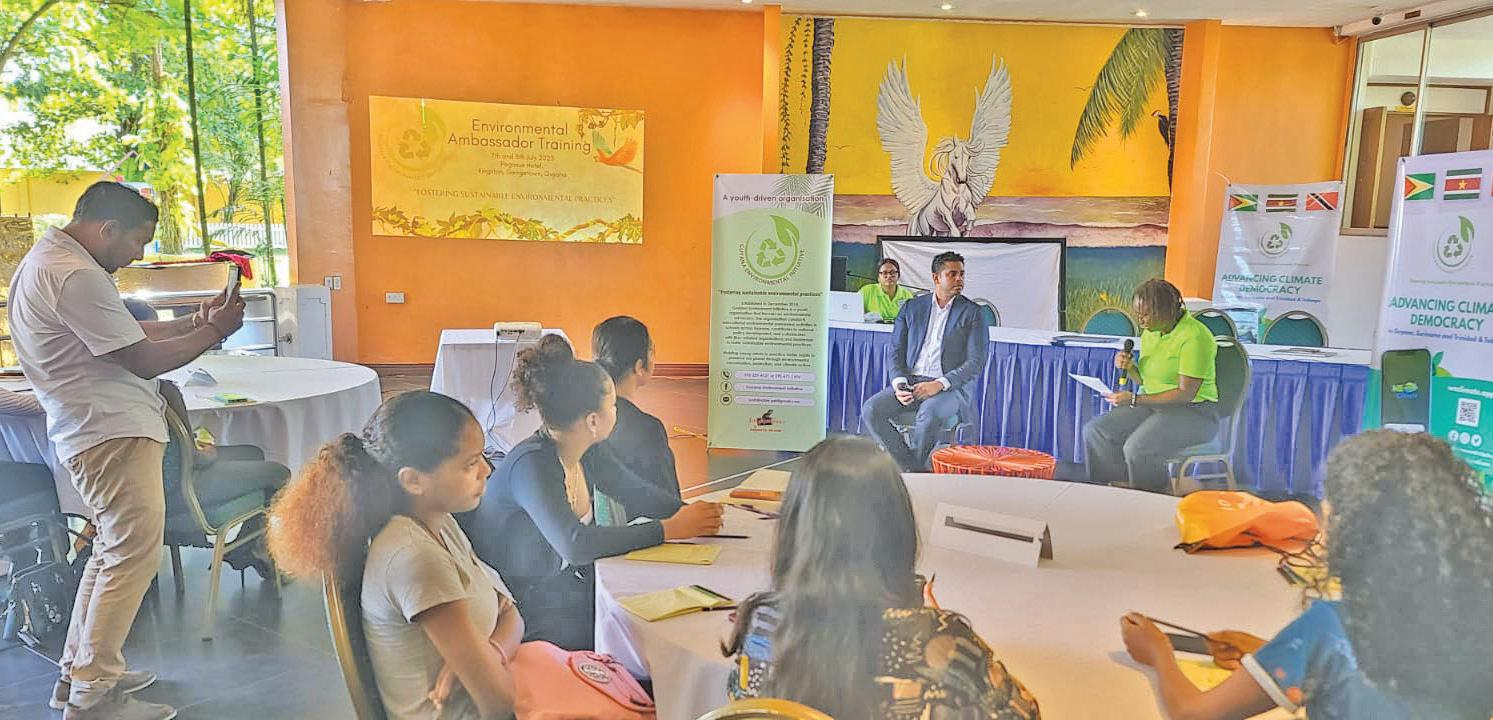
More than 50 youths across Guyana participated in a twoday training session hosted by the Guyana Environmental Initiative (GEI) to develop a cohort of climate champions to address climate-related concerns.
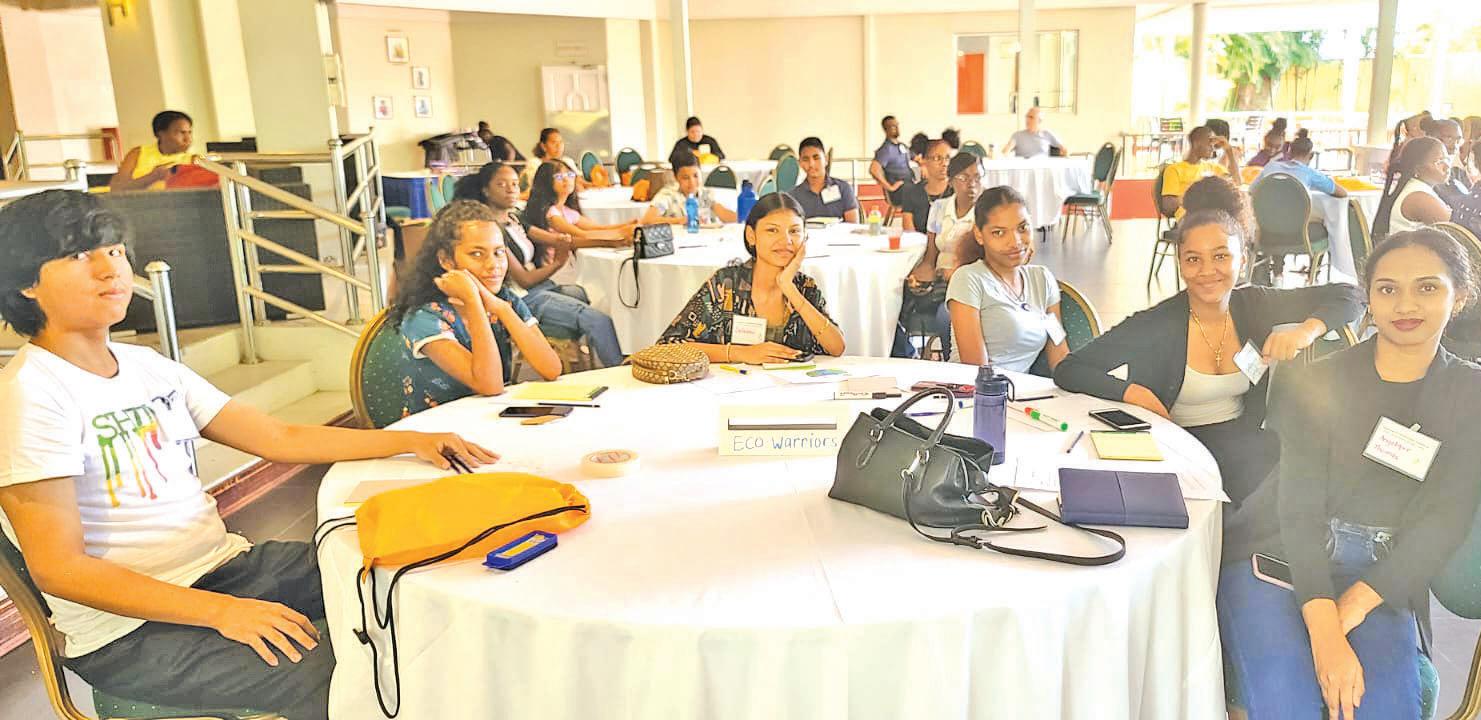
This inaugural two-day training included an introduction to environmental concepts, public speaking and presentation skills, pathways to being a youth ambassador, digital communication, the importance of wildlife, grey and green sea defence systems, environmental laws, careers related to the environmental field and next steps towards climate action.
Training, in the form of
lations.
Participants also had the opportunity to pose questions to Culture, Youth and Sports
presentations and interactive activities, was facilitated by young professionals from various fields, including environmental, legal, communications, public and private sectors, and international re-
Minister Charles Ramson on his path to leadership as a young Government official.
Minister Ramson urged the young participants to continuously develop their talents, skills, and knowledge in
order to reach their full potential and achieve their goals.
GEI Founder, Gomin Camacho called on the youths to share their learnings with their communities and schools and execute meaningful action towards fostering sustainable environmental practices.
She added that as Youth Environmental Ambassadors, they must lead by example and ensure their daily actions are geared toward creating a cleaner and healthier environment.
Notably, the participants ranging from ages 13-21, were representatives of the rich diversity of our country as they hailed from Regions Three (Essequibo IslandsWest Demerara), Four (Demerara-Mahaica), Five (Mahaica-Berbice), Six (East
Berbice-Corentyne) and 10 (Upper Demerara-Berbice).
This training was one of several activities being executed by GEI as the implementing partner for Guyana under the United Nations Democracy Fund (UNDEF) project "Advancing Climate Democracy in Guyana, Suriname, and Trinidad and Tobago.”
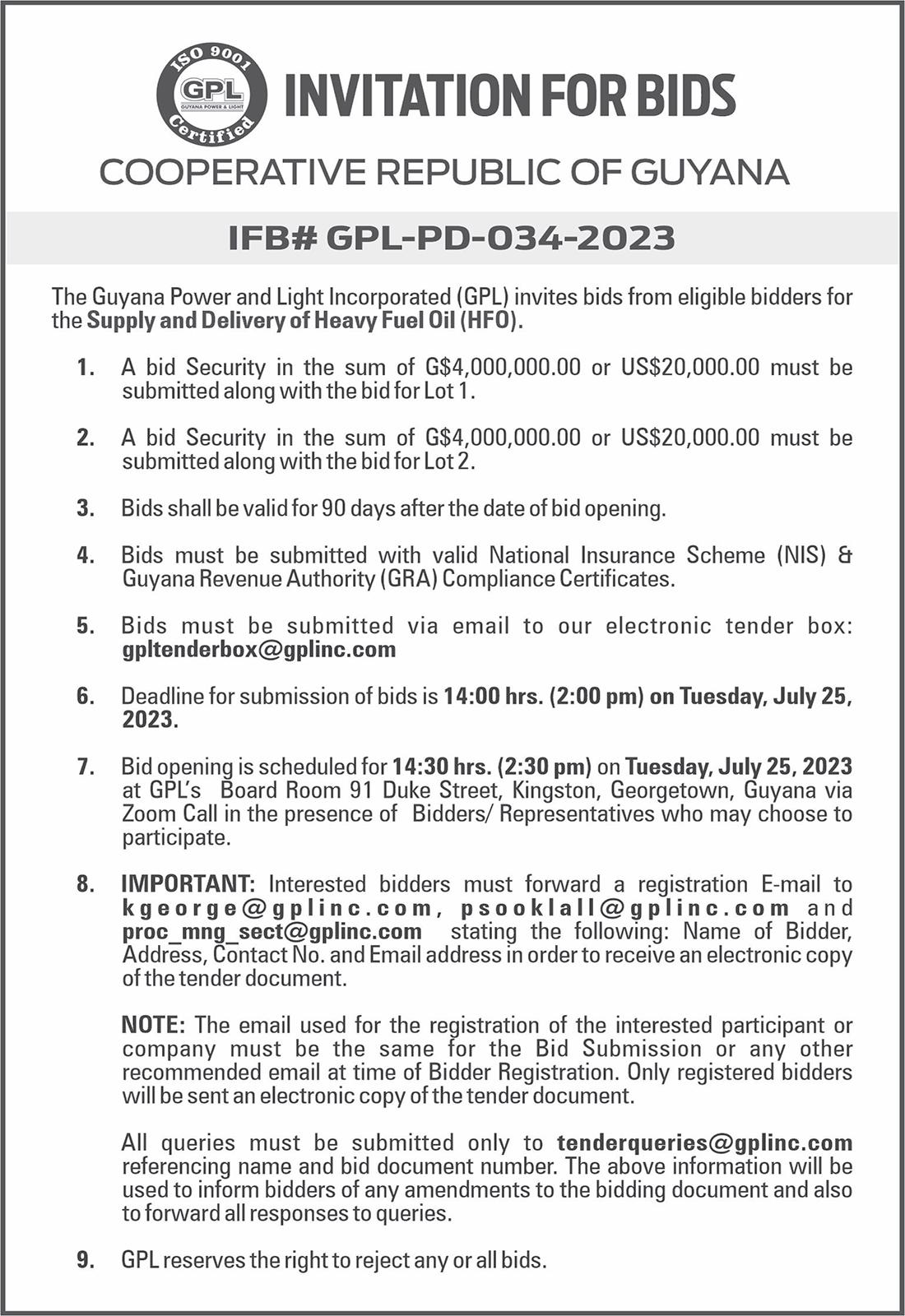
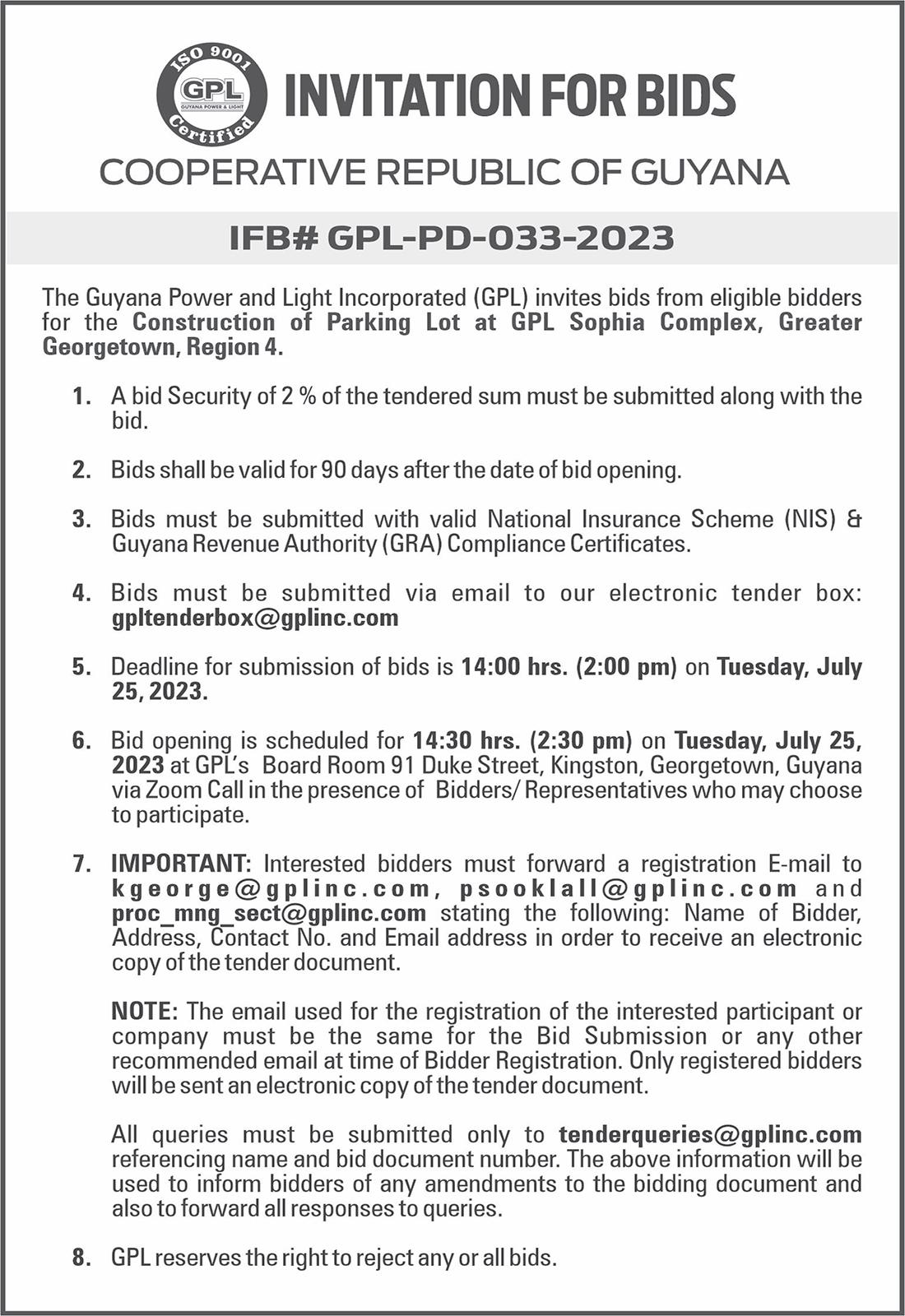
It was made possible with the financial and inkind support from the following sponsors: United Nations Democracy Fund, Ministry of Natural Resources, Ministry of Parliamentary Affairs and Governance, GT&T, Impressions Branding, Nicky's Juice, 55 Photography, KHE Engineering, and most importantly, the dedicated members and volunteers of GEI.
“By investing more efforts in reducing gender gaps and empowering women and girls, we can lay the foundation for more inclusive and prosperous societies while reversing the historical injustices meted out to women and girls.”
“On this World Population Day 2023, Guyana pledges its continued support for efforts to unleash the power of gender equality. Guyana is committed to creating a society where women and girls can aspire to realise their potential, fulfil their dreams and contribute their unique talents to shape a better world for future generations,” the President further said.

Last year, Guyana was favourably ranked on the Global Gender Gap Report 2022 produced by the Switzerlandbased World Economic Forum, with the report listing Guyana at 35 out of 146 countries and second in the Caribbean for reducing gender inequality.
According to the report, Guyana received a score of 0.752. The report notes that
Guyana’s score is a 0.024 improvement on its 2021 index score. Barbados, ranked at number 30 with a score of 0.765, was the only Caribbean country to be ranked above Guyana.
Meanwhile, Jamaica, which was ranked at 38 with a score of 0.749, was the next closest country. When it comes to the entire Latin America and Caribbean (LAC) Region, Guyana is ranked number six. The report notes that in Guyana, men and women have near equal rights when it comes to access to financial services, as well as access to land and non-land assets. Meanwhile, there are equal rights to inheritances for widows and daughters. When it comes to education and skills, there were only three categories where more men than women existed in the workforce. For instance, 38.2 per cent of the workforce in agriculture, forestry, fisheries and veterinary sciences are women, compared to 61.7 per cent men.
WEDNESDAY, JULY 12, 2023 | GUYANATIMESGY.COM
The suspects who were held in connection with the death of boat captain Carl Subratie, whose body was discovered in Marshall Falls, Lower Mazaruni River, earlier this month, have been released from Police custody.
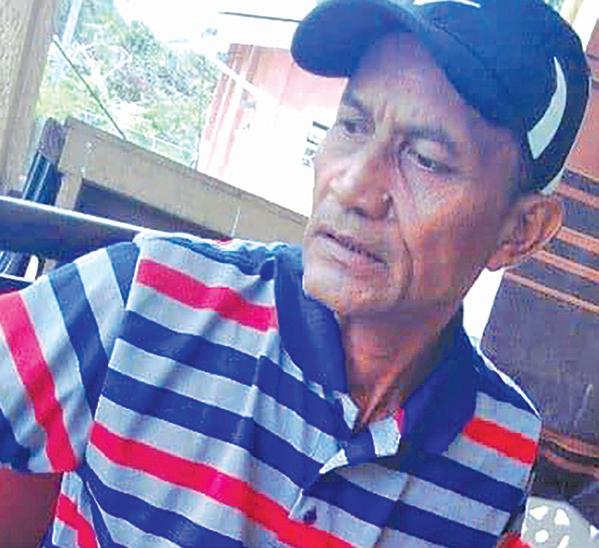
This information was confirmed by Police officials on Tuesday. According to detectives, although several persons were questioned, no substantial evidence linking the suspects to the incident has been found thus far. However, it has been stated that the investigations are ongoing, and the Police are continuing their efforts to gather further information to ascertain the circumstances surrounding the man’s death.
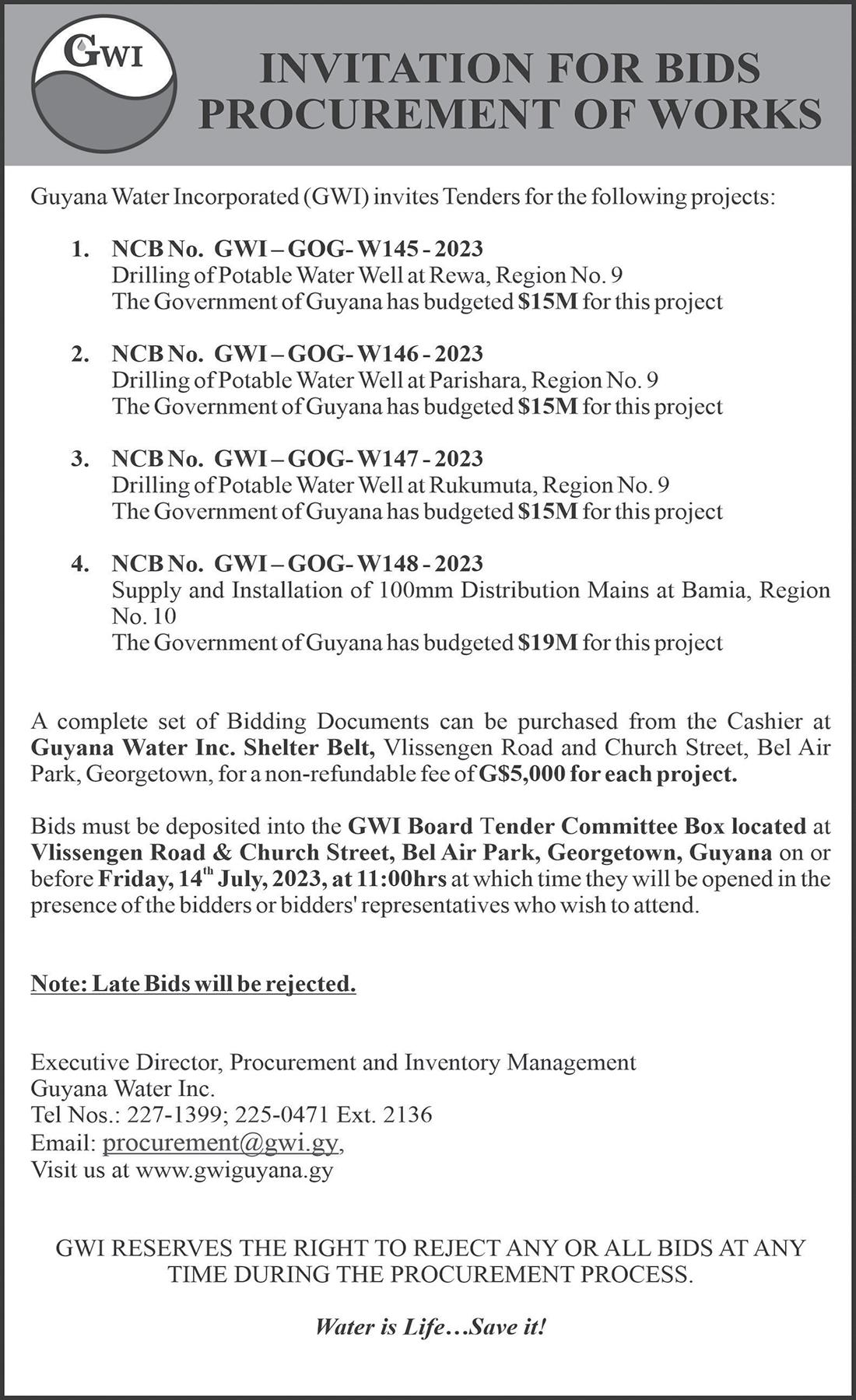
Carl Subratie, 61, had been reported missing on June 19.
According to Sameena Subratie, the man's daughter, her father had lived alone and had worked as a boat captain for the past 27 years, primarily operating in various interior locations.
The family had grown concerned on Father's Day, the day after Subratie had left home, when attempts to contact him on his mobile phone had been unsuccessful.
Despite calls being continuously made until Monday morning, there had been no response, and that had prompted Sameena to reach out to her uncles to inform them of the situation. The boat captain's brothers had visited the location where he had dropped off the passengers, and had been informed that he had indeed completed the task and had left the area to return home.
Upon the brothers' return home, they had reported the matter to the Police, and after several days of searching, Carl Subratie’s body was discovered. It had been found face-down in the river, and had exhibited several bruises and lacerations. It had also been indicated that the body was in an advanced state of decomposition.
The body had been taken to the Bartica Regional Hospital,
where, after examination, a doctor had officially pronounced the man dead. It had later been taken to Georgetown, where a postmortem examination conducted had determined the cause of death as multiple injuries.
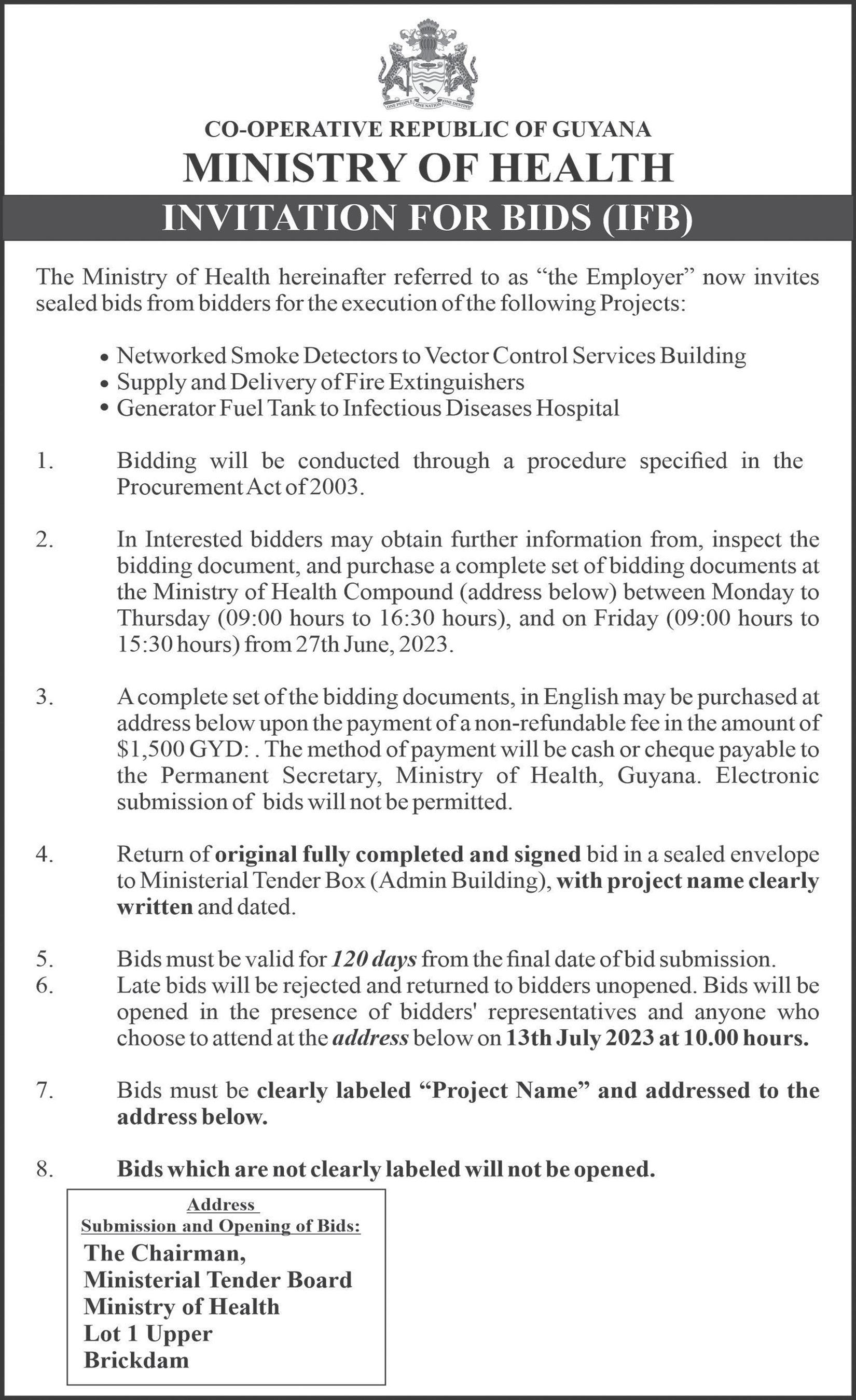
A family member had subsequently expressed concerns regarding the case.
"We knew that this was a murder because his boat was not found, and he was not decomposed like someone who would be in the water for 13 days. Also, we were told by the doctor who did the post-mortem that the multiple injuries on his body look like he was tortured for days…
"Also, he [the doctor] said that he only died about three to four days before we found his body, which means that, nine days before he was found, he was alive and maybe held hostage, where he might have been tortured. We know about five persons were arrested, but maybe more could be involved. We are angry about this," the relative had stated.

Following their arrest, the suspects were released, but family members of the late Carl Subratie continue to call on the Police to work on getting those responsible for the man's death arrested.
Linden motorcyclist, Selwyn Archibald of 735 Industrial Area, Mackenzie, Linden, who died in an accident along the Houston Public Road on Saturday last, had a defective bike, according to his brother.
Marcus Archibald told Guyana Times that the 36-year-old father of two had purchased the motorcycle some time ago but due to the deficiencies, he had taken it back to the company in Georgetown to have it fixed.
On the day of the accident, he left his home and went to Georgetown to pick up the motorcycle after some repairs were done to the gear clutch. It was during his return home that he was involved in an accident.
"He told me that he was coming to town to pick up the bike and that he was $10,000 short to get it fixed. So, I told him to come and work with me the day before. It's like this boy knew he was going to die because I've never seen my brother work so hard that day," the brother related.
"We usually work together in the interior, but when we're out, we would catch our hand with weeding. He left that day without telling us he was going to town. But before that, when he told me he was going for the bike, I told him not to ride it. I suggested he bring the bike up on the back of a canter because the bike has a lot of speed, and I don't know if he can control it," Marcus added.
He pointed out that before the accident, Selwyn went to the head office of the company he worked for and spent
some time there with his friends. About 20 minutes after leaving the office, he was involved in an accident.
"...when he left, he told his friends that he was in a hurry and planned to ride fast and return to Linden. As soon as he pulled off, his bike cut out, and he restarted it. Soon after, the accident happened," Marcus explained.
According to the Police report, Selwyn's motorcycle, bearing registration number CK 5480, collided with a concrete utility pole while he was travelling at high speed. He reportedly lost control while negotiating a turn thus resulting in the collision.
CCTV videos showed the severity of the injuries – one of his legs nearly severed. He was unconscious, and Emergency Medical Technicians arrived to transport him to Georgetown Public Hospital for treatment where he later succumbed.

More than 1000 persons turned up at the Guyana Shore Base Inc (GYBSI) Career Fair, which was held on Sunday last at the West Demerara Secondary School, Region Three (Essequibo Islands-West Demerara).
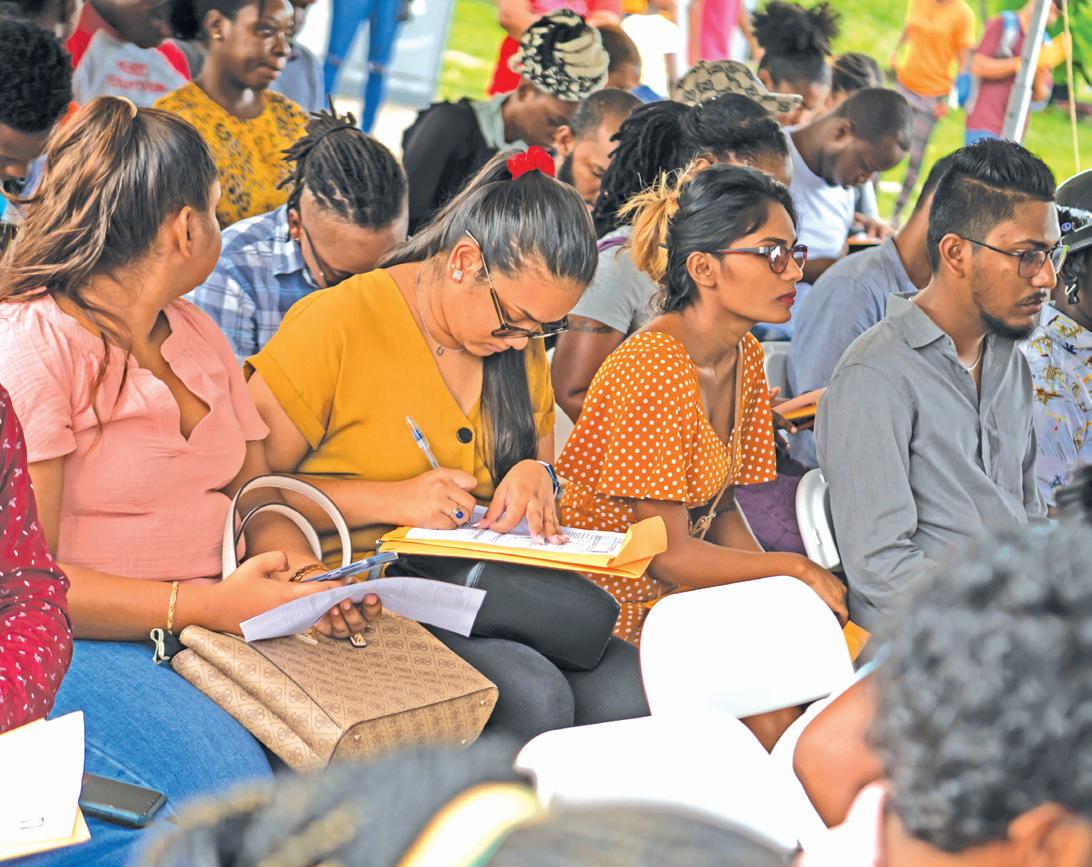
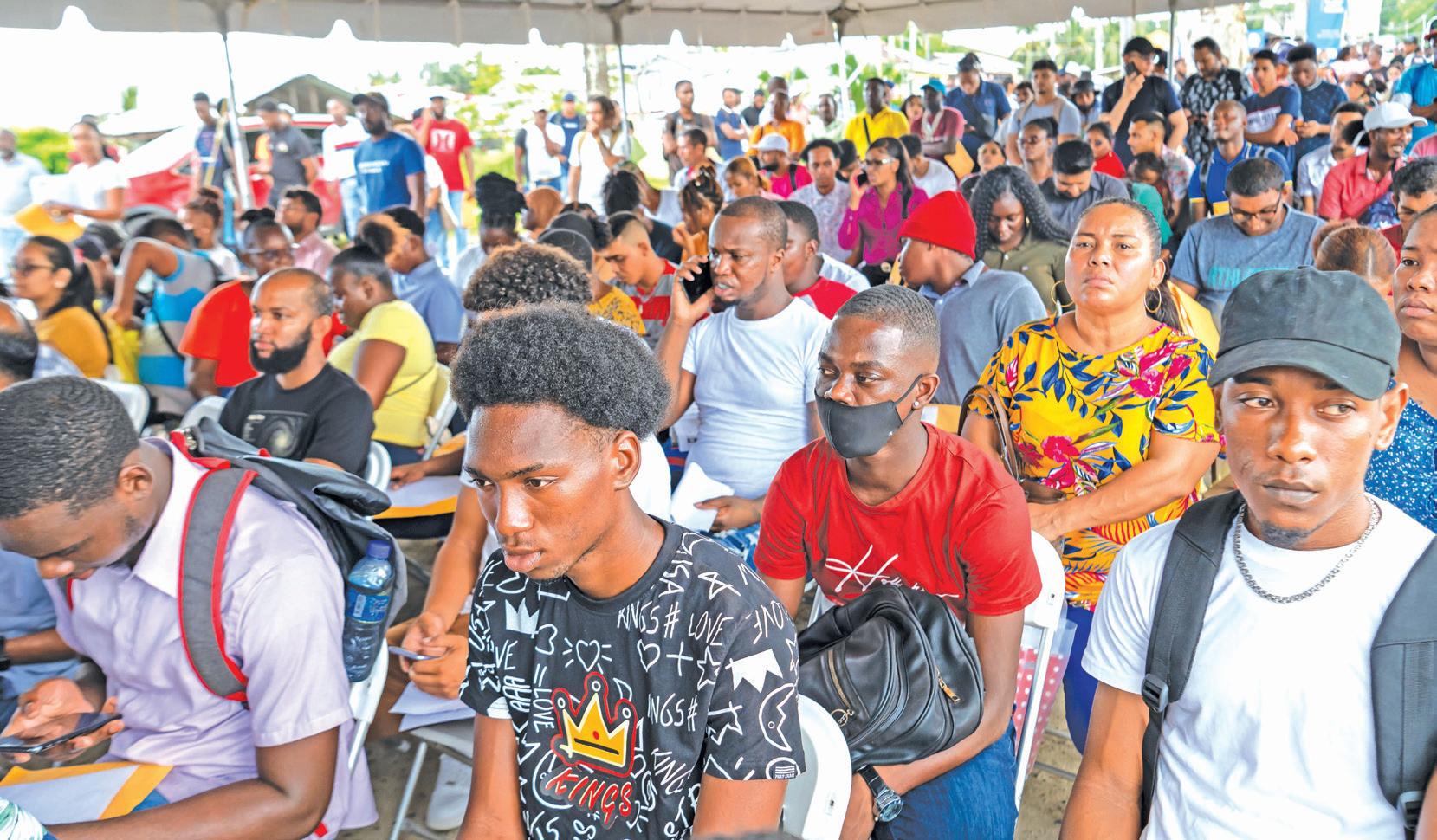
During the event, several persons were hired on the spot to fill various positions including Excavator Operator, Human Resources Officer, Dispatcher, Banksmen, QHSSE Officers, QA/QC Field Inspector, Technical Administration Assistants, Cleaners, and Operations Assistants, among others.
These persons will be supporting a component of the gas-to-energy project, which is being undertaken by the Government of Guyana and ExxonMobil Guyana in the same region.
Human Resource Manager of GYSBI Lilowtie
Chintamani stated that the turnout was unexpected, but the company was able to hire skilled technical persons on
the spot since many of them met the requirements.
“It was indeed a shock to me to come out here and see so many people. We said we would interview persons and look at their documents and then call them but for all those persons who had all their relevant documentations, we hired them on the spot, especially those we would like to
start working on Phase 1 of the project. There were some technical spots like excavator operators/heavy duty operators and persons walked with all their certificates and other documentation that were required, so we hired them.”
She also stated that since the project site will be based in Region Three, the company was desirous of hiring per-
sons living in that area.
“It would be easier for us to hire persons from over here because of the timings for this project. I must say that when I talked about our shift system of work for this project, people didn’t react the way they used to a year or two years ago. In previous times when you tell persons about shift work, they would usu-
The Caribbean Public Health Agency (CARPHA) is preparing countries to bolster its infodemic management capabilities, as it facilitated training for 23 Member States at the Regional Health Communication Network (RHCN) Meeting.
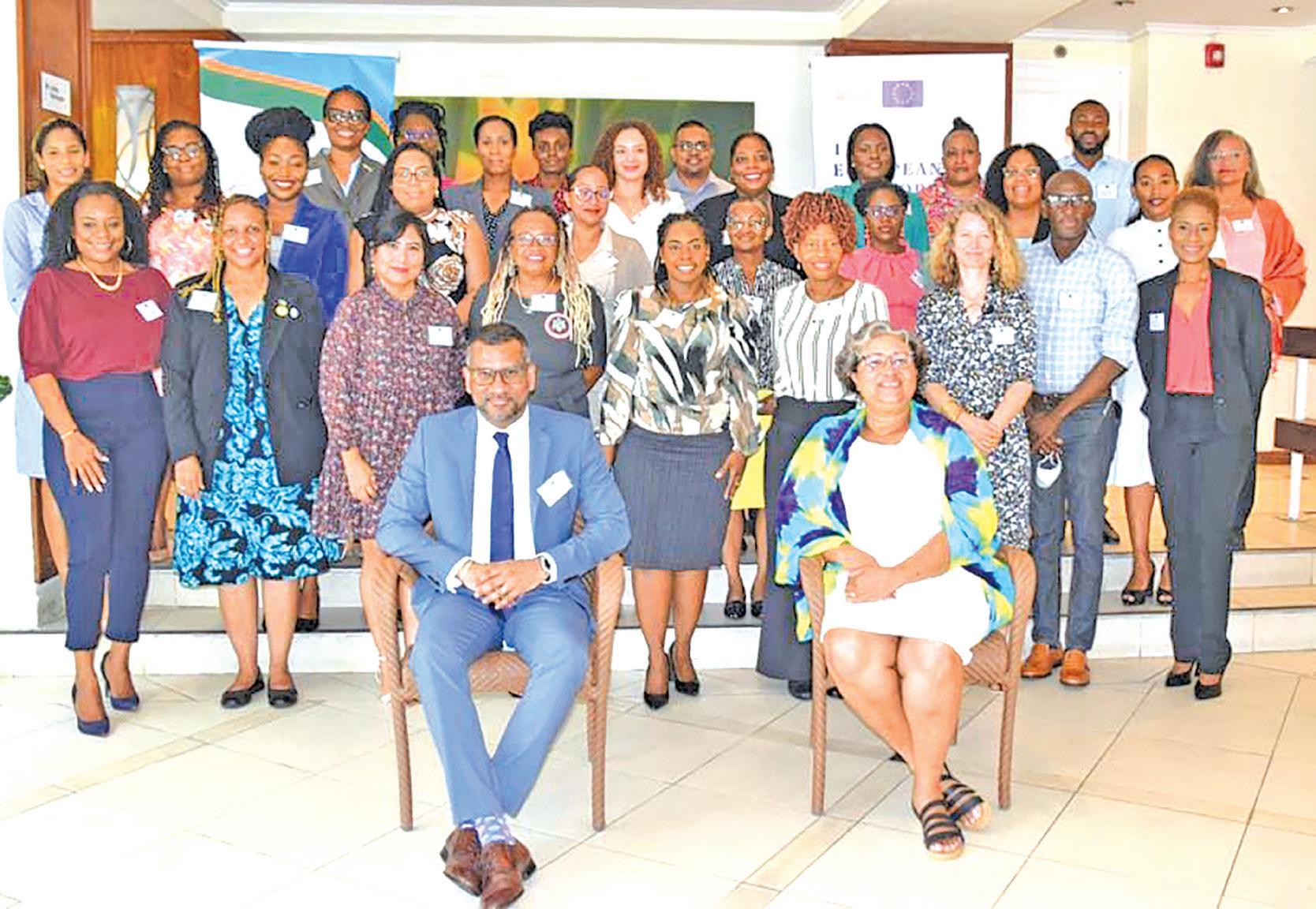
During the two-day workshop, participants utilised case studies and simulation exercises to assist in building capacity to respond and develop infodemic management interventions; understand the impact of infodemic management; learn to detect and understand the spread and impact of infodemics.
The meeting also provided the opportunity for participants to strengthen their country’s risk communication plans through the development of a framework for infodemic management. Monitoring and evaluation of projects was also part of the training agenda.
Director of Corporate Services at CARPHA, Dr Mark Sami stated, “The goal of the meeting is to support the strengthening of risk communication in Member States by focusing on skills needed in infodemic management, which we all would agree is extremely critical given the difficulty that persons faced in finding clear messages and trustworthy sources during the COVID-19 pandemic”.
Additionally, CARPHA Executive Director, Joy St John explained that this year’s focus on infodemic management aims to en-
sure that people have the right information at the right time in the right format.
“Your messages have to bring about behavioural changes during epidemics to protect their health and the health of their loved ones and communities…Let us all remember that the ultimate impact of all the public health efforts we are making is to change the behaviour of the people. The community is our largest partner; therefore, we must go where the people are.”
Permanent Secretary of the Health Ministry in Barbados, Wayne Marshall said this focus on infodemic management is timely, as there is always need for preparation in managing the flow of health-related information in times
of widespread social media and internet use.
Marshall opined, “Infodemic management is imperative in helping to reduce the impact on health behaviour during emergencies. The use of evidence-based analyses and approaches is necessary as we seek to build capacity to manage information and protect the health of our Region. We must be able to engage, empower and listen to our communities.”
The RHCN was established by the Caribbean Public Health Agency (CARPHA) in 2015 to develop, implement, sustain, monitor and evaluate communication responses to priority health issues in the Region.
Pledging her support, Team Lead on Infodemic
Management at the World Health Organisation, Tina Purnat disclosed, “It is a pleasure to see how the investment and the importance of the health communication network in your Region is not only in sharing health information in communities, but also sharing experiences and working strategically on building capacity amongst yourselves. There are tools that you will be able to learn over the next two days that I hope will be useful to you. We will be happy to bring your experience and your feedback back into our global network for infodemic management where we discuss and make sure that the tools and assistance amongst members are the best possible.”
ally turn it down but most of the people who came out here were open and willing to work the shifts, which are from 6:00h. From an HR perspective, we are very pleased.”
In addition, Chintamani indicated too that the activity also provided the opportunity for GYSBI to receive curricula vitae from the attendees, which will help to scope out the skillsets and expertise, which are available in the region, to fill other employment opportunities on the project.
Public Relations Manager of GYSBI, Gomatie Gangadin explained that 95 per cent of the attendees were young people, many of whom were looking for an opportunity to work and participate in any capacity in the oil and gas industry.
While the company was looking to directly hire workers from Region Three, she noted that there were also persons who came from Regions 4, 5, 6, and 10.
However, 18-year-old Dominic Bess was one of the lucky persons who was hired on the spot. In an invited comment, he said, “The interview was great for me. The staff was really professional. I was
hired on the spot, and they said they would call me within a week so I am just looking forward to starting at GSYBI. I think it is a great company and I am excited to start.”
In addition, Tenisha Bandhu, 22, who was also hired on the spot, noted that she is grateful for the opportunity as it will not only assist her financially but will also provide much-needed job experience.
“I must say that I was hired on the spot for the position of Technical Admin and the position and salary are way better than what I am currently earning. This is a really good opportunity for me because I was looking for betterment and I am studying to go into the oil and gas sector. This job will also help me to get the experience I need to aid in my studies. I am just really overwhelmed by this opportunity.”
GYSBI serves as the premier shore base and onshore logistics hub for the oil and gas industry here in Guyana. It is a Guyanese company and one of the leaders in local content development. More than 95 per cent of its workforce are Guyanese citizens.

There is an old saying that remains as relevant today as it has ever been in history: “We are only as strong as our weakest link”. There are many variations of this lingo. One relevant one for Guyana is that our democracy is only as strong as our weakest link. Guyana does not need much research to identify our greatest weakness, our weakest link, our greatest threat to democracy.
Deputy Chief Education Officer (Administration), Fazia Baksh has announced that the Education Ministry will enhance its monitoring of classroom activities and teachers’ performance, in a bid to achieve improved results in the future.

She made this disclosure during the recent announcement of National Grade Six Assessment (NGSA) results, citing that teachers are responsible for developing the abilities of children.
Dr Leslie RamsammyFrom its inception, the PNC has always been Guyana’s weakest link and our greatest threat when it comes to our democracy.
There are really no “ands, ifs and buts” about this. While the PNC’s authorship and leading role in rigged elections are well known and well documented in Guyana and well known around the world, rigged elections and overall cheating at elections only represent some of the genes in the PNC’s overall anti-democratic DNA.
Ever since the PNC’s founding-leader tried to cheat Cheddi Jagan out of the leadership of the PPP, post-1953 elections, the PNC has had a continuous anti-democracy trajectory. Unfortunately for Guyana, the PNC’s antidemocracy assault is now more than seven decades long. Rigged elections and their violence-prone protests are only part of the anti-democracy DNA. Every day, through other actions, they are determined to remind Guyana that their own role in Guyana is to grab power at any and all cost.
The PNC makes no bones about their place in Guyana’s continued struggle to ensure democracy prevails. The latest manifestation of their anti-democracy posture is the ongoing swearing in of councillors and appointments of committees for municipalities and NDCs. In the largest of these, the Mayor and City Council of Georgetown, a council that has been plagued for more than 60 years by unaccountability and financial squander, the PNC used its majority to appoint its candidates as Mayor and Deputy Mayor. It appointed as Mayor a person who lost his constituency in the June 12th LGE. Imagine, the people of this man’s constituency rejected him, and yet the PNC used its majority to foist him on the City as Georgetown Mayor.
He was previously Deputy Mayor of Georgetown, and was part of an executive which was infamous for unaccountability. He was part of the City’s executive which has not subjected its accounts for auditing for many years. But during last week, when the councillors were sworn-in, the PNC used its majority to put the Mayor on the Finance Committee of the Council. It also used its majority to appoint five other members on the seven-man committee, leaving only one space for the PPP. Where is the PNC’s commitment to accountability and democracy?
The PPP won almost 45% of the votes in Georgetown, and deserves to represent the people, not just in the overall council, but also in the committees.
In New Amsterdam, where the PNC won 8 of the 14 seats, it not only appointed both the Mayor and Deputy Mayor, but also excluded PPP members from any of the committees. New Amsterdam is another of the municipalities plagued with unaccountability. The Finance Committee is made up exclusively of party members who have been identified with the unaccountable status in New Amsterdam for decades. The talk of commitment to democracy is just trash talk. It is manifested across Guyana in the thirteen municipalities and NDCs they have control of.
The new Mayor of Georgetown, in thanking his colleagues for electing him, called on the political parties to work across the table to ensure they serve the people with optimal effectiveness and efficiency. It was a noble call. But almost in the same breath, the mayor supported his colleagues to lock out the PPP from vital committees in City Council. The mayor, who called for working across the table, insisted that it is the PPP’s fault that it was locked out from committees. In his book, the PPP needed to ask for inclusion. When the PPP nominated persons for committee membership, it asked for inclusion. If the mayor’s call was genuine, he could have implored his colleagues to give a certain number of PPP members a chance, for example, to be part of the Finance Sub-Committee. It is an empty call, and dishonest in declaring your willingness to work across the table while at the same time telling those on the other side you do not belong. It is ingenious and wicked.
The mayor wants to put the past behind, bury the hatchet. He and his PNC colleagues had a chance to show that they want to work as a team for Georgetown and its citizens. The first opportunity to show they are serious about harmonious team work for Georgetown, the mayor himself failed. He is being pilloried not for the past, but for his present action. Georgetown and other municipalities and the NDCs cannot expect the PNC members to show they can help strengthen our democracy and work in the interest of the people.
“In an effort to ensure improved results incrementally, there will be more emphasis on the monitoring and supervision of classroom teaching and teachers’ continuous professional development. Teachers need to be fostered continuously to achieve the required competencies because teachers have roles to grow and nurture students’ abilities professionally,” Baksh revealed.
Added to this will be re-
furbishments to not just the physical settings but the curriculum. The Ministry has been aiming to achieve equity among learners regardless of the respective variables involved.
The DCEO posited, “There will be infrastructural enhancement and upgrades to the curriculum so that every child has equal access to learning regardless of the school the attend. Such strategic interventions by the Ministry of
Education will auger well for the improvement in performance of our students regardless of race, class or culture across Guyana.”
In 2018, the curriculum reform process commenced after it was found that the framework was not reviewed in some three decades.
The Cyril Potter College of Education (CPCE) has also committed to having 100 per cent trained teachers in classrooms across Guyana by 2025 – a goal which was set in the Education Ministry’s strategic plan. Guyana’s teaching capacity received a timely boost earlier in the year when over 800 persons graduated from the college in 2022, marking the largest group of graduates in the institution’s history.
Two categories of untrained teachers currently exist in the education system: those who are eligible for admission at CPCE and those who are not. The latter is being upgraded, so that they can
enter the college programme. Also, by 2025, the Education Ministry is working on achieving universal secondary education, bridging the divide in education quality across the country by providing students with proper facilities to participate in additional subject areas.
It signed several multimillion-dollar contracts to rebuild Christ Church Secondary School, St George’s High School, and St Mary’s Secondary School.
Last week, contracts totalling over $3.4 billion were signed for the construction of the Tuschen, and Hosororo Secondary Schools in Regions Three (Essequibo IslandsWest Demerara) and One (Barima-Waini), respectively. Most recently, the US$5.15 million Good Hope Secondary School on the East Coast of Demerara and the GY$585 million Abram Zuil Secondary School on the Essequibo Coast were also commissioned. (G12)
Several contractors, who had signed contracts with the Government to clean canals in Region Six (East Berbice-Corentyne) have been employing the services of other companies (sub-contractors) to carry out the work.
This is according to Region Six Chairman David Armogan.
The Chairman made the disclosure while addressing the Regional Democratic Council (RDC) at a recent meeting.
“They’re not doing the work,” he told the RDC.
He was at the time responding to claims that some contractors have been using chemicals to kill weeds growing along the edges of the canals.
He pointed out that using chemicals in the waterways affects aquatic life and also farmers who depend on the waterways to irrigate their fields.
Additionally, Armogan said those who have been contracted to clean the road shoulders are not giving the Government value for its money.
“That is one of the
things that I reported to the Minister and they are going to have a serious look at that because they don’t supervise the work. When I asked one of the workmen who he was working with, he called another man – not the contractor that we are dealing with.”
He said as it relates to that particular contract, the contractor is reportedly overseas.
“We are paying lots of money to have these placed well-kept and we are not getting value for money.”
According to Armogan, the standards have to be
kept at all times.
“They have high heaps of grass on the banks of the road and they are not moving them. I have even seen some of them picking the grass up and putting them in bags and the bags are not being removed for weeks,” the Chairman pointed out.
Armogan called on Councillors to be vigilant and report to the regional administration, instances where contractors are not working in accordance with the regulations. This, he said, will allow the administration to take the necessary action.
Ajoint exercise which saw several arms of national security of Trinidad and Tobago working together Monday morning resulted in 200 Venezuelan nationals being detained after it was discovered they were undocumented.
The detainees were held as they partied at a popular bar along the Western Main Road, St James.
The group, which included people between the ages of 17 and 46, were subsequently taken to the Heliport, Chaguaramas.
The exercise sanctioned by ACP Maharaj, coordinated by Snr Supt Henry, and spearheaded by Insp Davidson and Sgt Adams also included members of the Defence Force as well as the Immigration Division.
Officials carried out the raid between 1.30 am and noon yesterday, and interviewed the attendees who were reportedly guests at a birthday party hosted by the manager of the establishment and another business owner.
Among them were several male individuals dressed as women.
Officials said a final count resulted in 96 males and 95 females being detained, as they were suspected to be illegal immigrants after failing to produce any documents permitting them to be in T&T.
A senior police officer yesterday confirmed to Guardian Media that they were conducting further investigations to ascertain whether there were any breaches of the law as it relates to the licence under which the business is being operated.
Referring to the exercise as an act of refoulement yesterday, attorney Criston J Williams said, “From my understanding, many of them are holders of identification cards issued by the UNHCR. And this provides international protection for that individual not to be forced to return to their country.”
The Quantum Legal head said the raid and sub-
sequent detention of people, especially those granted permission by the UNHCR, was contrary to international law and could adversely affect T&T’s standing globally.
Williams challenged Prime Minister Dr Keith Rowley as head of the National Security Council to break his silence on the matter and say definitively if this country intended to withdraw from the 1951 Refugee Convention.
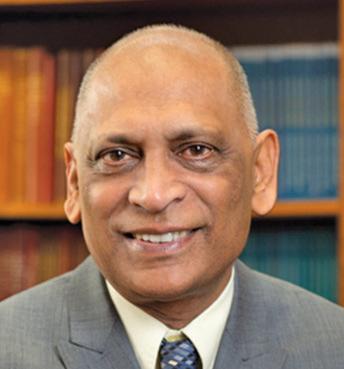
Meanwhile, local activist Yesenia Gonzalez expressed sadness and anger over the situation.
Admitting she was aware of the raid, she claimed, “My information is that many of them are asylum seekers who are here in transit to places like Canada.”
Acknowledging the authorities had a job to do, she said, “This is heartbreaking.”
She defended them, “They are not breaking any other laws, yet they are being arrested and detained like criminals, and most
likely they will be deported.”
Pointing to the record number of murders and other crimes being committed, she angrily demanded lawmen stop targeting migrants and labelling them criminals.
She said the State had more serious issues to address than undocumented people enjoying a night out.
Gonzales claimed some of the detainees had been granted amnesty, but had not been in possession of their “cards” when held yesterday.
Last week, High Court Judge Frank Seepersad, while dismissing a hybrid judicial review and constitutional motion lawsuit brought by a Venezuelan refugee who was ordered to be deported by National Security Minister Fitzgerald Hinds in March, said asylum seekers and refugees can be deported from this country despite T&T being a signatory to a United Nations Convention that advises against such action. (T&T Guardian)
Oil prices jumped on Tuesday, settling up about 2%, boosted by a falling US dollar, hopes for higher demand in the developing world and supply cuts by the world's biggest oil exporters.
Brent futures rose US$1.71, or 2.2%, to settle at US$79.40 a barrel. US West Texas Intermediate (WTI) crude rose US$1.84, or 2.5%, to settle at US$74.83.
Brent's settlement was its highest since April 28 and WTI's since May 1. Brent was in technically overbought territory for the second time in three days.
"The break of the recent high could be viewed as a bullish step that could give (Brent) the momentum to break back above US$80," said Craig Erlam, a senior market analyst at OANDA. "The rally still has momentum at this stage," he added.
US diesel futures were also on track for their highest close since April 18.
The US dollar dropped to a two-month low against a basket of other currencies a day after several Federal Reserve officials signalled the US central bank was near the end of its tightening cycle.
A weaker dollar makes crude cheaper for holders of other currencies.
US small business confidence climbed to a sevenmonth high in June as pessimism about the economic outlook diminished sharply and sales expectations improved, but a still-tight labour market continued to drive concerns about inflation.
Markets were awaiting US inflation data on Wednesday for clues on the interest rate outlook. Higher rates can slow economic growth and reduce oil demand.
The International Energy Agency (IEA) said the oil market should remain tight in the second half of 2023, citing strong demand from China and developing countries combined with recently announced supply cuts, including by top exporters Saudi Arabia and Russia.

The IEA will publish new forecasts this week.
The Secretary General of the Organisation of the Petroleum Exporting Countries (OPEC) said global energy demand is forecast to rise 23% by the end of 2045.
The US Energy Information Administration (EIA) projected global oil output would rise from 99.9 million barrels per day (bpd) in 2022 to 101.1 million bpd in 2023 and 102.6 million bpd in 2024, while world demand will rise from 99.4 million bpd in 2022 to 101.2 million bpd in 2023 and 102.8 million bpd in 2024.
That compares with a record 100.5 million bpd of global oil production in 2018 and a record 100.8 million bpd of world liquids consumption in 2019.
EIA also projected US crude output would rise from 11.9 million bpd in 2022 to 12.6 million bpd in 2023 and 12.9 million bpd in 2024, while US liquids consumption would rise from 20.3 million bpd in 2022 to 20.4 million bpd in 2023 and 20.8 million bpd in 2024.
That compares with a record 12.3 million bpd of US crude production in 2019 and a record 20.8 million bpd of liquids consumption in 2005.
With analysts in a Reuters poll forecasting a 0.5-million barrel increase in US crude stocks during the week ended July 7, that inventory data could weigh on oil markets.
If correct, it would be the first crude stock build in four weeks and compares with an increase of 3.3 million barrels in the same week last year and a five-year (20182022) average decrease of 6.9 million barrels . (Reuters)
President Joe Biden has declared a state of emergency in Vermont after torrential downpours triggered life-threatening flash floods.
The move frees up federal government resources to support the state, which is expecting to see more heavy rain throughout Tuesday.
Roads in some areas are entirely underwater and people have been left trapped in their homes.
Emergency teams have already performed dozens of rescues.
Parts of the north-eastern US, including New York and Vermont, have seen some of the most severe flooding in more than a decade in recent days. Dangerous flash floods are expected to remain a risk until at least Tuesday evening.
"If flooding approaches your home evacuate to higher ground sooner rather than later, your route could be compromised by floodwaters and leave you stranded," a press release from Vermont emergency officials said.
Rescue teams have come from North Carolina, Michigan and Connecticut to help with the life-saving efforts. Several areas of Vermont are inaccessible, and with further rain forecast the crews are likely to face challenging conditions.
Most of the rescues so far have taken place in the towns of Londonderry, Weston, Bridgewater, Andover, Ludlow and Middlesex.
Vermont's capital, Montpelier, ordered the downtown area to close until at least midday on Tuesday

Rivers in Vermont reached high levels on Monday, but were expected to recede on Tuesday
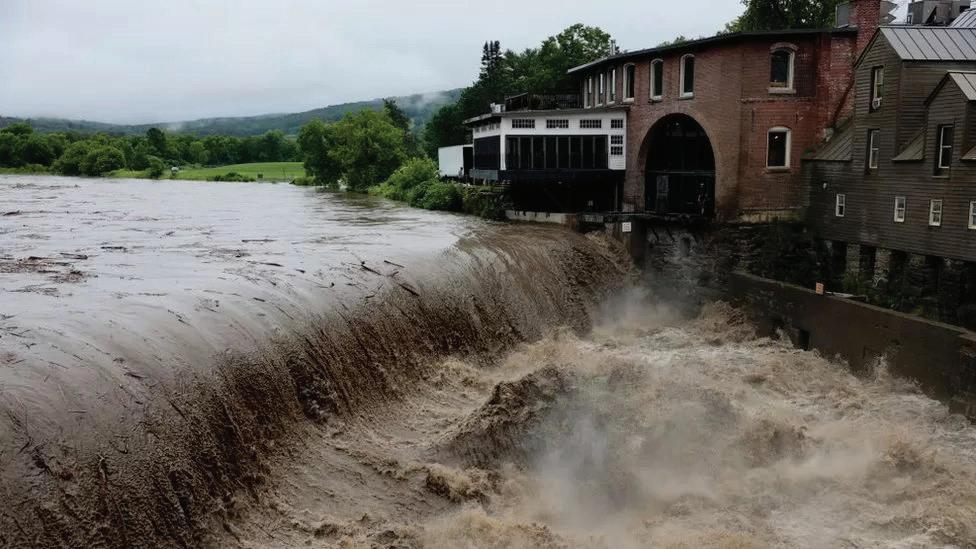
as a river that runs through the city recedes. "This will allow officials to assess safety risks and begin clean up efforts," William Fraser, a city official, said.
There were major concerns overnight about three dams in the state that were nearing capacity. Referring to the prospect of one of
them overflowing, Fraser earlier said: "This has never happened since the dam was built so there is no precedent for potential damage."
But on Tuesday, officials eased fears when they said they no longer expected the dams to overflow. (Excerpt from BBC News)
Vivid helmet camera videos filmed by Ukrainian soldiers at the front line can give viewers a visceral feel of combat as Kyiv's counteroffensive finally unfolds, even though experts warn against drawing strong conclusions about how the war is going.
Ukrainian officials have been tight-lipped about the long-awaited operation since it was launched in June, and independent news crews are generally barred from filming operations while they are under way.
The information vacu-
um has been partially filled by a steady stream of video filmed by soldiers themselves and often compiled, edited and released by their units.
Shot from cameras on helmets and vests and beamed to the world from the front lines, many of the images have a first-person intensity and immediacy virtually unseen in combat footage filmed by professional news crews in previous wars.
In one recent video edited and released by the 3rd Separate Assault Brigade,
Bank of America has been ordered to pay out US$150M (£116M) in penalties after it was found to have opened credit cards without customers' permission.
Regulators also discovered the bank "double-dipped" fees from customers and withheld promised reward bonuses.
The violations at the US's second largest bank affect hundreds of thousands of customers and date back to 2012 in some cases, regulators said.
Bank of America has not admitted or denied the investigation's findings.
The bank has been ordered to refund customers and pay a total of US$150M in penalties to the Consumer Financial Protection Bureau (CFPB) and Office of the Comptroller of the Currency (OCC).
Customer refunds are expected to be worth more than US$80M, the CFPB
said.
The regulator said Bank of America illegally applied for and enrolled consumers in credit card accounts without their knowledge or authorisation to help bank employees reach sales incentive goals.
Customers were charged unjustified fees and "suffered negative effects to their credit profiles", said the CFPB.
Bank of America is also accused of double-dipping fees that were charged when a customer had insufficient funds in their account.
People were charged US$35 when a transaction was declined. But Bank of America allowed fees to be repeatedly charged for the same transaction.
The lender said it has since ended charging the US$35 fee for insufficient funds and reduced overdraft fees. (Excerpt from BBC News)
troops poured out of an armoured personnel carrier near the eastern city of Bakhmut, unleashing a hail of gunfire as they advanced toward an enemy position.
The viewer is soon overwhelmed by chaos and violence as troops shriek commands at one another and hurl grenades and obscenities at the enemy.
An explosion erupts just metres away from the camera, sending debris flying and leaving troops disoriented. Later, an exhausted commander lets out an expletive at the camera after
a Russian artillery strike on his unit's position.
Such footage, especially if selective and curated, cannot answer important questions such as the enemy's level of resistance, said Nick Reynolds, of the Royal United Services Institute think-tank in London.
"However, what is clear is that some of the fighting is extremely hard."
Reynolds added that the videos can also provide a feel for the artillery-scarred terrain Ukrainian troops are fighting on. (Excerpt from Reuters)
Indonesia's coast guard said on Tuesday it seized an Iranian-flagged supertanker suspected of involvement in the illegal transhipment of crude oil, and vowed to toughen maritime patrols.
The MT Arman 114 was carrying 272,569 metric tons of light crude oil, valued at 4.6 trillion rupiah (US$304 million), when it was seized last week, the Indonesian authorities said.
The Very Large Crude Carrier (VLCC) was suspected of transferring oil to another vessel without a permit on Friday, the Southeast Asian nation's maritime security agency said.
The vessel was captured after being spotted in Indonesia's North Natuna Sea, carrying out a ship-toship oil transfer with the Cameroon-flagged MT S Tinos, the agency's chief, Aan Kurnia, said.
"MT Arman was spoofing their automatic identification
system (AIS) to show its position was in the Red Sea but in reality it is here," Aan told reporters.
"So it seems like they already had a malicious intent," Aan said, adding that the vessel also dumped oil into the ocean, in violation of Indonesia's environmental law.
Along with the Arman, authorities detained its Egyptian captain, 28 crew and three passengers, who were the family of a security officer on board, the agency said.
After the two supertankers attempted to escape, authorities focused their pursuit on Arman, assisted by Malaysian authorities as the vessel sailed into their waters, Aan said.
The risk of oil spills and accidents is growing as hundreds of extra ships, some without insurance cover, have joined the opaque parallel trade over the past few years.
(Excerpt from Reuters)










You can talk your way into anything today, but your dreams will crumble if you don’t follow through with your promises. Offer only what’s feasible, and be willing to work hard.
PICKLES

(March 21-April 19)

Social events won’t unfold as anticipated. Rethink how you spend your time and be honest about what you will and won’t do. Risks will lead to regrets. A change of heart is apparent.
(April 20-May 20)




Don’t be fooled by the information someone offers you. Signing up for something that you’re unsure about will put you in a vulnerable position. Don’t get angry. Follow your heart.

(May 21-June 20)
PEANUTS



(June 21-July 22) (July 23-Aug. 22)

CALVIN AND HOBBES


(Aug. 23-Sept. 22)


A physical change won’t unfold as anticipated. Don’t give someone the right to be your fashion or health expert. Research is in your best interest. Distance yourself from harmful situations.
Think twice before you start something you cannot finish. Protect your reputation and position. Don’t expect someone to cover for you. Use your experience and knowledge to push forward.
A change will lift you and boost your confidence. Travel, educational pursuits and activities that encourage spending time with friends, relatives or colleagues will pay off.

Control your emotions and let your intelligence shine through. Don’t feel the need to pay for others or get involved in a joint venture. Keep your sights on what makes you happy.
(Sept. 23-Oct. 23)

Put your current situation in perspective and consider what you’d like more of in your life. A change at home that adds to your comfort or eases stress will make a world of difference.
(Oct. 24-Nov. 22) (Nov. 23-Dec. 21)








SOLUTION
(Dec. 22-Jan. 19)
Pay attention to money matters. Update documents, accounts and credit cards to reduce unnecessary annual fees and interest payments. Taking control will put your mind at ease.
Spend more time nurturing what’s important to you. Don’t take chances with your personal life, possessions or money. A change at home will result in closer ties with loved ones.
Think twice before you pick a fight with someone. Assess your relationships, intentions and the changes you want to make before sharing your thoughts and feelings.
(Jan. 20-Feb. 19)
Follow your plans, and you’ll feel good about your accomplishments. Invest more time and money in yourself and the skills you need to pursue the life you want to live.
(Feb. 20-March 20)


DeNobrega, one of Guyana’s top junior players, initially trailed Leacock by a set and a break, but the youth displayed some incredible athleticism to force the errors off Leacock’s racquet and secure the second set.

After trailing 0-3 in the decisive set, an ailing Leacock was forced to retire, and subsequently denied a spot in his first Men’s Open Singles Semifinal in seven years.
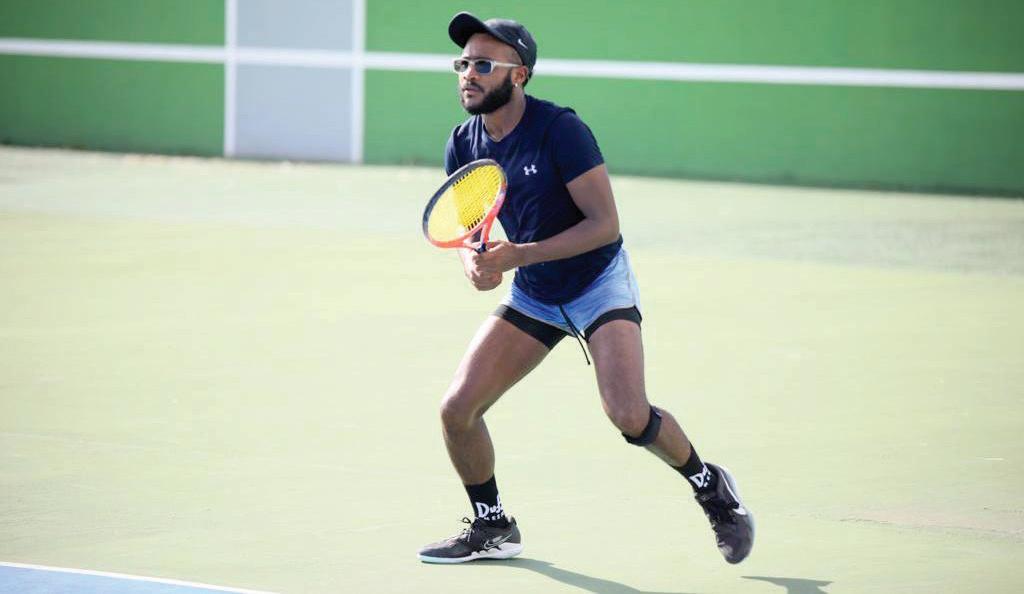


The Guyana Table Tennis (GTA) “One Guyana” Open 2023 tournament is a pillar of the emerging National Sports Academy, and is an initiative which is funded by the National Sports Commission (NSC); the Ministry of Culture, Youth and Sport, and by extension the Government of Guyana.
Gavin Lewis, the #2 seed, has advanced to the semifinal of this tournament with a 6-2, 6-0 win over Sandeep Chand.
“It was a good win today compared to my last match. Every match is different and important. I stayed focused throughout the match, and I’m happy to be back in a Men’s Singles Semifinal,” the former #1 has said.
It was the pair’s first meeting at the singles level, and Lewis, the 2019 GBTI Champion, won the last seven games of the match.

“Usually, around this time I’m competing at the GBTI Tournament in Bel Air, but I’m grateful for the opportunity to compete at such a high
level against some of the best players in Guyana,” Lewis has said. “Special thanks to the GTA and the Government of Guyana. I’m looking forward to more tournaments of this calibre.”
Meanwhile, the #5 seed, Nathan DeNobrega, has beaten the seasoned Leyland Leacock in
This junior player De Nobrega will next be facing former Men’s Champion Phillip Squires.
Other Results

In the Men’s Open Singles Round of 16, Seanden DavidLonge defeated Martin Campbell 6-1, 7-6 (4).
In the Men’s Open Singles Quarterfinals, Phillip Squires defeated Anthony Downes 6-4, 6-3.
The 32 teams are confirmed, and now the fixtures are out for the inaugural Kares’ “One Guyana” T10 Tape ball Blast, set for July 29 and 30 in Georgetown. The fixtures, computer-generated to avoid any bias in the selection and to offer a fair chance for every team to make the semi-finals, have hinted at cracking action from match one: from 09:00h on Saturday, July 29. The ten-overs-per-side tournament will be played in a straight knockout format, with opening day matches being played at the Guyana Defence Force Ground, Police Sports Club Ground, and Queen’s College Ground, while the semi-finals and grand final will be on July 30 at the Everest Cricket Club Ground.
To progress to the championship match, a team must win three matches on day one and their semi-final on day two. They will then qualify to compete for the first prize of $1M cash and the specially-crafted One Guyana Trophy.
first-place prize and offset the transportation cost for team Moruca.
Round of 32 fixtures: Matches starting at 09:00h
a comeback match to reach his first Men’s Open Singles Semifinal. He registered a score of 1-6, 6-4, 3-0 (ret.).
In their first encounter,
In the Men’s 45 Singles Round Robin, Aubrey Younge defeated Harry Panday 6-4, 6-2. And Sunil Bianchini defeated Patrice Stewart 6-0, 6-1.

on the game, which requires his email, but they are rejected. They stole my phone, and Bluetooth box,” Coach Nedd has said.

According to the senior Nedd, they have gotten a suspect, and a police report has already been made.
Garvin Nedd is a former senior national cricketer, and is the current Guyana Harpy Eagles Head Coach.
Commenting on the draw, the Co-Director of the tournament, John Ramsingh, has said, “We, as a team, were stunned after the fixtures were generated, and I truly believe it will be like a final from match one. I wish I could be in three places at once, to watch all of the matches, but I can’t. So, I hope fans come out in their numbers and do the same, keep taking photos and videos.”
Banks DIH, through the GT Beer, is being thanked for fuelling the weekend. Star Rentals, Avinash Contracting and Scrap Metal Inc., ENet, Regal Stationery and Computer Centre, V-Net Communications, Trophy Stall, Premier Insurance, Cricket Zone USA, Beacon Café, Continental Transport; Ministry of Culture, Youth and Sport; National Sports Commission, RS53 RestoBar and Lounge, Jacobs Jewelry & Pawn Shop, First Change Builder Inc. Impressions Inc. and Sicko Mode are all likewise being thanked for their participation in making this tournament possible.
The inaugural champions will pocket $1M, while the losing finalist will collect $300,000. The two losing semi-finalists will walk away with $100,000 each. There will also be prizes for outstanding individual performances.
Eccles All Stars vs Hero Riders – Queen’s College Ground
Ministry of Human Services and Social Security vs Bartica Bulls –Queen’s College Ground
Avinash All-Stars vs PB Contractors – Queen’s College Ground
Continental Transport vs Moruca XI – Guyana Defence Force Ground
Eastsye vs Airport XI – Guyana Defence Force Ground
The United Crew vs Spartan Strikers – Guyana Defence Force Ground
Village Rams vs Young Steppaz – Police Sports Club
Ministry of Housing & Water vs Central Stars –Police Sports Club Matches starting at 11:00h

Ariel XI vs Movements
Family – Queen’s College Ground
Guyana Harpy Eagles
Assistant Coach Garvin Nedd and his son national cricketer Ashmead Nedd were robbed at their home last week. Among the items stolen are cricket gear and souvenirs.

According to Coach Gavin Nedd, the items stolen included his son’s Guyana Amazon Warriors cricket
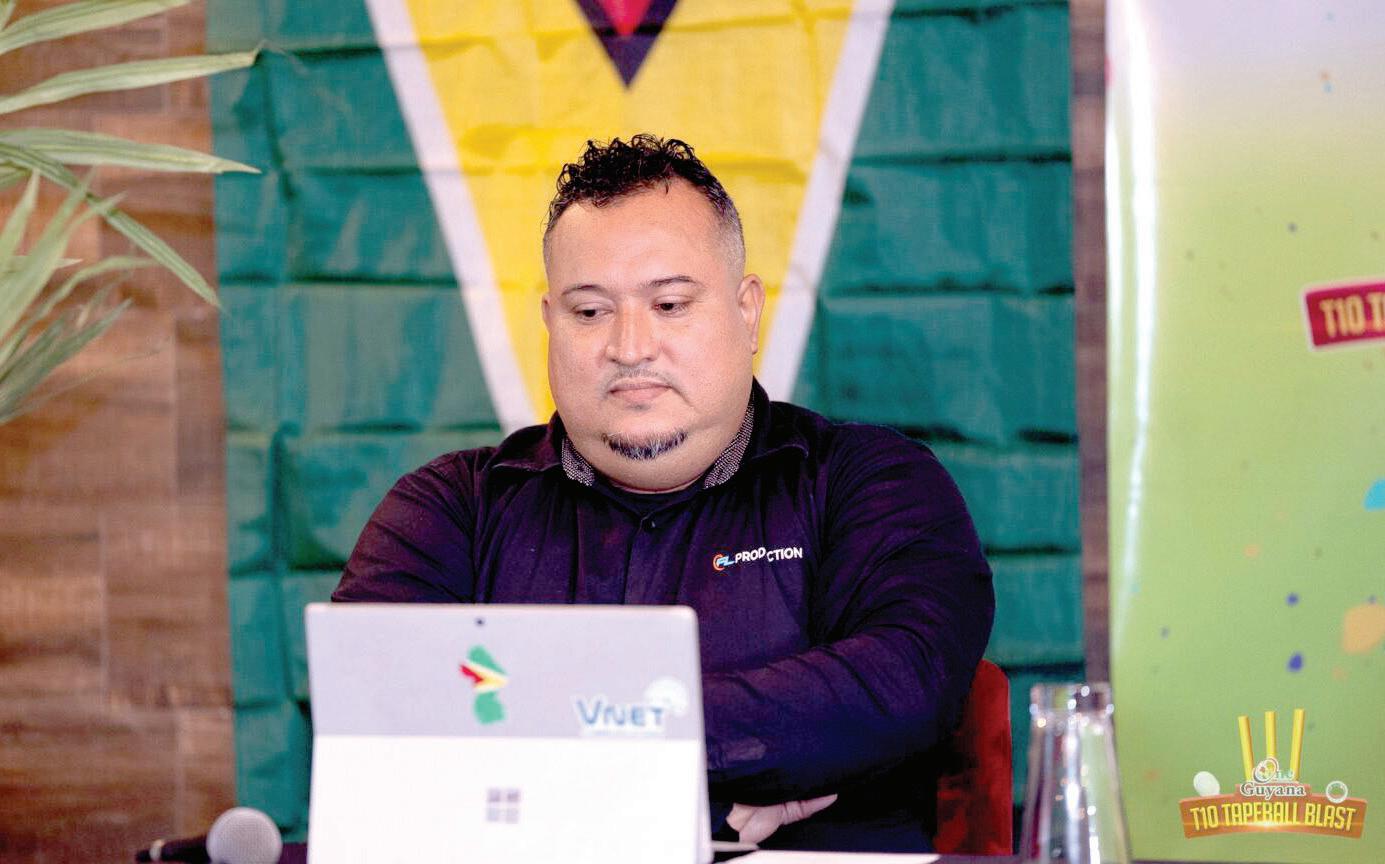
gear bag, his son’s SM cricket gear bag, and a souvenir (game) from Indian legend Virat Kohli.
“I was robbed here in my home, where I am living in Herstelling. They stole something from Ashmead, including a game (PS5) that was given to him from Virat Kohli. They (individual/s) that stole it are trying to put
His son Ashmead has represented the West Indies Under-19, the Guyana Amazon Warriors, the West Indies Academy, Leeward Islands, Jamaica Tallawahs (CPL 6IXTY) and was a net-bowler in the Indian Premier League.
Ashmead has also been a selectee for the Guyana Harpy Eagles in the recent Regional Four-Day tournament.
He added, “It is hard to pick any favoured side, and we love that it gives all teams a fair chance to reach the final four, where there will be cash prizes. My wish again is for teams to follow the rules and be respectful of the umpires, whose call is final. The finals are expected to be streamed live, and we want to show the world we have a quality product in Guyana.”
Ramsingh noted that teams have until July 14 to submit final squads, after previously submitting preliminary squads.
Furthermore, the CoDirector has expressed immense gratitude for the support of Kares Engineering, who quickly committed to being the title sponsor, and to Mohamed’s Enterprise, who funded the
Additionally, there will be a celebrity match before the championship match. The winning side thereof will be rewarded $200,000, which will be donated to a charity of their choice.
The celebrity match will feature the President, Dr. Irfaan Ali; former national and international cricketers, entertainers, sponsors, media members, athletes, former and current Ministers, and other influential persons in Guyana.
The Co-Director has revealed that it is not only players who will walk away with their pockets filled, as there will be numerous instant prizes for the fans who participate in cricket novelty activities. At the same time, the children will be pampered with free rides, games, and treats in the Banks DIH Fun Zone.
Big B’s Blairmont Blazers vs MS 13 XI –Queen’s College Ground
Team Corruption vs Upsetters – Queen’s College Ground
Guyana Power & Light vs Laluni – Guyana Defence Force Ground
1Name Brand vs Storm Chasers – Guyana Defence Force Ground
Tarmac Titans vs EC Express – Guyana Defence Force Ground
Diamond Gunners vs Region Three Police –Police Sports Club
Avery Lounge vs V-Net Vipers – Police Sports Club
Round of 16 matches commence at 13:30h at all three venues, while Super Eight matches start at 16:00h and will be held at Police and Guyana Defence Force grounds only.
The semi-finals and final are on July 30 at Everest Cricket Ground.

4 steals followed by Kelon Phillips who did not miss out on the action with 5 points and 6 rebounds.
Martin Edwards swished the ball for 10 points and 13 rebounds, but that was not enough to carry his team over the finish line.
President’s College thumped their way through the defenses of St Stanislaus, with two points being the decider, the score being 32-30 in favour of President’s College.
Judah Ferreira of President’s College showcased his shooting ability with an astonishing 9 points, followed by Aiden Semple with 8 points, 3 rebounds, and 3 steals
Kwakwani Secondary

will be looking to secure their Seventh Senior Boys’ Title against President’s College in the Boys U18 championship games of the ExxonMobil National Schools Basketball Festival 2023, set for play on Sunday, July 16, at the National Gymnasium
on Mandela Avenue in Georgetown.
Kwakwani Secondary, from Guyana’s mining Region #10, have continued their dominance to secure the inaugural spot in the final with a commanding 39–30 points.
Kasim English dazzled the crowd with an astonishing 21 points with 4 rebounds and
Defending champion Kwakwani Secondary will play President’s College A for ExxonMobil's National School Basketball Festival 2023 Championship at the National Gymnasium

Kwakwani Secondary trumped Marian Academy to a scoreless 56 points to zero points to secure their place
in the final. Deandra Hodge, with an exceptional performance, scored 14 points and 7 rebounds, followed by Lanesha Mohammed with 12 points and 6 rebounds.
Malia Samuels, Sherel Leacock and Rihanna Archer did not miss out on the scoresheet, scoring 8 points each.
President’s College A de-


feated President’s College B with a commanding 14 points to 3 points to secure their spot in the final showcase.
Akeela Campbell continued to showcase her shooting skills with 6 points, 4 rebounds and 5 steals, followed by Chrisleyann Richards scoring 6 points and 6 rebounds.
The Berbice Educational Institute (BEI) have emerged
champions of the Digicel Schools Knockout Football competition in Region Six


The Guyana U19 Girls team have defended a total of 84 runs to beat their Jamaican counterparts by 25 runs in the ongoing Cricket West Indies Regional U19 Girls tournament being played in Trinidad and Tobago.
Nya Latchman picked up four wickets, while Cyanna Retemiah and Ashmini Munisar each took two for Guyana.

Batting first, Guyana girls posted 84 all out in 28.4 overs. Sarah Amin top-scored with 23, while skipper Munisar, who returned from West Indies senior duties, scored 16. Kate Wilmott was the star bowler for Jamaica with 3-18 from 5.4 overs.
Jamaica’s U19 Girls then managed 59 all out in 19.1 overs. Extras top-scored for the Jamaicans, with the Guyanese giving 20 extras to the total. Latchman had 4-15 from 5.1 overs, while Retemiah had 2-9 and Munisar had 2-13.
Guyana U19 Girls will play hosts Trinidad and Tobago on Thursday, July
(East Berbice-Corentyne).
In the final, played on Monday at the All Saints Ground on Princess Elizabeth Road in New Amsterdam, BEI prevailed 3-2 over Vryman’s Erven Secondary.
The ever-constant Colsis Scipio opened the BEI scoring in the 50th minute, and three minutes later, T’Jon Reid made it 2-nil; but in the 61 minute, Akeem Hosannah pulled one back for Vryman’s Erven.
The game had gone into injury time when Vryman’s Erven found the equalizer off the boot of Keron
George, and ecstatic spectators roared in jubilation, but BEI’s Jamal Adams scored in the next minute, just before referee Gladwyn Johnson blew his final whistle, to give BEI the win by a score of 3-2.
Earlier, in the playoff for third place, Tutorial Academy overpowered New Amsterdam Multilateral 4-3 on penalty kicks after the two schools had played to a 1-1 stalemate at the end of regulation time. Xavier Ferreira had scored for New Amsterdam Multilateral, while Jordan Butts had scored for
Tutorial Academy. BEI, Vryman’s Erven Secondary, and Tutorial Academy will now advance to the Round of 24, which will involve schools from seven other regions.
This Digicel inter-school knockout football tournament has returned after a five-year absence. However, the tournament is not as extravagant as before, when all secondary schools in the country were given an opportunity to participate. Only 11 of the 13 secondary schools in Region Six have participated in this year’s competition.

FROM PAGE 23 ►
Lap Record
UNCHANGED
1:16.413 – Kristian
Boodoosingh – Radical SR3
Sunday 13th November
2022 – International Race of Champions – Radical Caribbean Cup, Race 1
or 6237805.
Vacancy for a house cleaner at a private house in Herstelling EBD. One female between the ages of 35 – 45 years, from the hours of 9 am – 3 pm, 6 days per week. Days and hours are negotiable. Kindly contact 592-673-5300.
ticularly poor against pace over the last three years, as the records suggest, with the dwindling form of the likes of Virat Kohli looming large as they attempt to fix a faltering middle-order.

The batting concerns mirror those of the home side as well, which showed up in South Africa earlier this year and have been forced to have a rethink. However, despite the changes, the batting order, bookended by two veterans in Kraigg Brathwaite and Jason Holder, remains heavily dependent on their performances. The series offers others in the ranks another opportunity to step up and match up to the riches that their pace attack otherwise provides for the team.
Twelveyears after India last played a Test match in Dominica, they return for a series-opener where the focus will largely be on the new personnel that will be driving their World Test Championship campaign.
Having finished as the runners-up twice in the competition, there have been a few bold calls made by the selectors in picking the squad,
among which will be that of the new #3 in the absence of Cheteshwar Pujara. Contenders for the slot are newbies Yashasvi Jaiswal and Ruturaj Gaikwad, both coming in after impressive first-class and IPL performances in recent times. The importance of filling that slot suitably is increased when India's batting failures are taken into consideration.

The line-up has been par-
Their potency in Tests, particularly at home, has largely been down to the pace exploits led by Kemar Roach, with Shannon Gabriel and Alzarri Joseph adding more firepower. And it is a facet that India's transitioning team will look to emulate.
In the absence of Mohammed Shami, the mantle of lead pacer belongs to the ever-improving Mohammad Siraj. Nevertheless, the focus will be trained towards the next line of attack, where there is an element of rawness that has the potential to even up
the match-up between the sides over the course of two Tests.
What to expect: Historically, the venue has favoured spin bowling (87 wkts, 23.35 Avg, 48.5 SR) more than pace (80 wkts, 28.43 Avg, 68.5 SR). The possibility of a few showers, according to weather forecasts, could also influence selection calls.
The lack of a left-hander in India's top order could tilt the scales in favour of Yashasvi Jaiswal earning a Test debut on the back of a domestic season in which he averaged over 80 in firstclass cricket. The other burn-
ing selection calls would be over the choice of the wicketkeeper and the toss-up between an extra pacer or R Ashwin. His historical record against the opponents, and the venue traditionally aiding spinners could work in favour of the veteran off-spinner.
India Probable XI: Shubman Gill, Rohit Sharma, Yashasvi Jaiswal, Virat Kohli, Ajinkya Rahane, Ravindra Jadeja, KS Bharat/Ishan Kishan, Ravichandran Ashwin/ Shardul Thakur, Jaydev Unadkat, Mohammad Siraj, Navdeep Saini
After lacklustre outings
against South Africa on their tour there earlier, West Indies have dropped big names such as Roston Chase, which could pave the way for debutant Alick Althanaze as a batter, while his offspin duties could be transferred to Rahkeem Cornwall, who hasn't featured in a Test in over two years.

West Indies Probable XI: Kraigg Brathwaite, Tagenarine Chanderpaul, Raymon Reifer, Jermaine Blackwood, Alick Athanaze, Joshua Da Silva, Jason Holder, Rahkeem Cornwall, Alzarri Joseph, Kemar Roach, Shannon Gabriel. (Cricbuzz)
The Guyana Motor Racing & Sports Club (GMR&SC), held its second circuit race event of the 2023 season, the South Dakota Grand Prix – Round 2, on Sunday last, and several lap records were reset during the course of the day. In some instances, those records were reset multiple times throughout the course of the day.
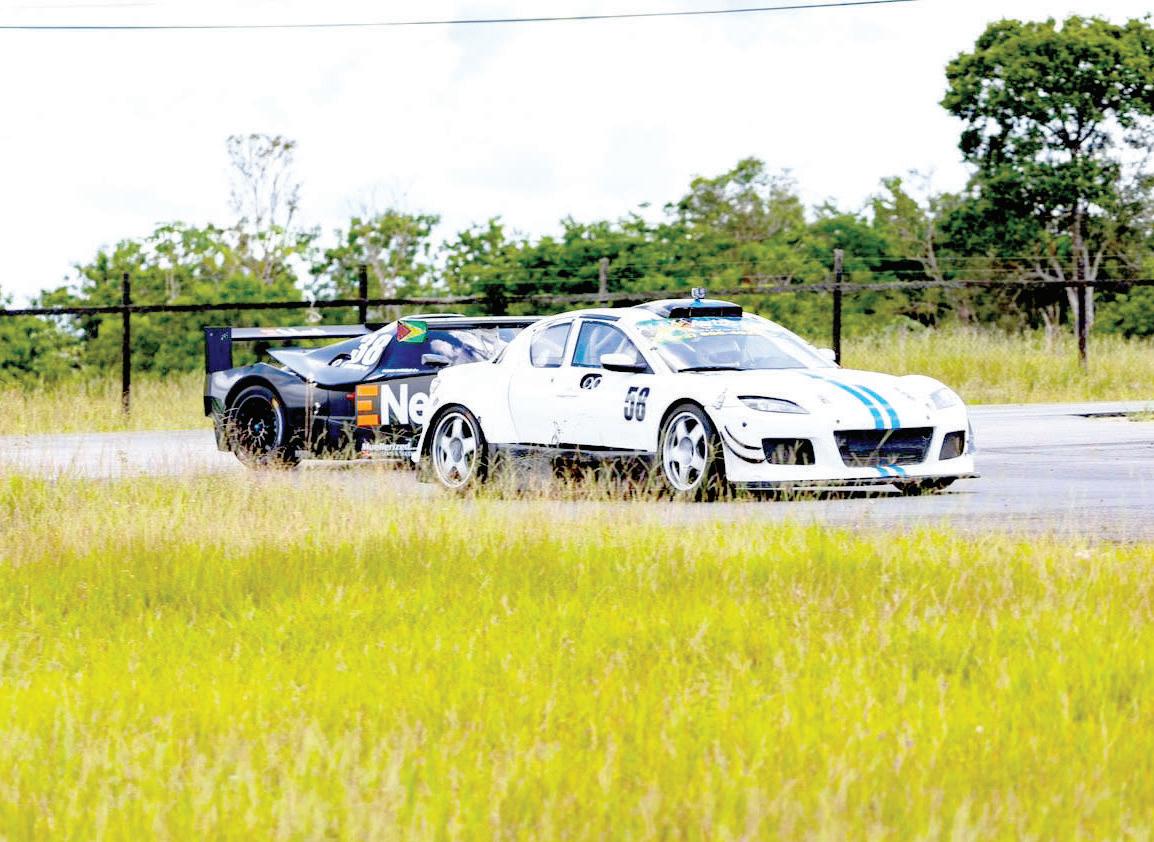
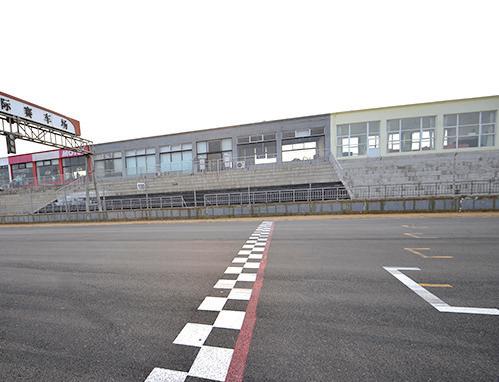
New records were set by Mohamed Ashad Ali (Rookie Class), Shan Seejatan (Group Two), Danny Persaud (Group Three), Heeranand Boodhram (Street Bike Class), and Matthew Vieira (Super Stock).
Some of the records reset were Lap Records – records which are set by each individual class, and are set only during an official race. Overall Track Records were also reset. An Overall Track Record is a record of the fastest time ever recorded at the track by any vehicle during any official session (practice, qualifying or race) using official timing equip-
ment only.
Below are the official results:
UNCHANGED
1:16.271 – Mark
Vieira – Radical SR3
Sunday 13th November 2022 –International Race of Champions – Radical Caribbean Cup, Free Practice 2
Rookie Class Lap Record NEW RECORD
1:33.416 –Mohamed Ashad Ali – Toyota Yaris GR
Sunday 9 July 2023 – South Dakota Grand Prix – Round 2 – Rookie Class, Race 1
Previous Records:
1:35.411 – Tarick
Baijnauth – Toyota Starlet
Street Tuner Lap Record
UNCHANGED
1:36.361 – Troy Muir –
Toyota Corolla
Sunday 19, March 2023 –South Dakota Grand Prix –
– Vickey Persaud – Toyota Starlet
Sunday 13th November
Sprinter AE91
Sunday 19th March 2023
– South Dakota Grand Prix –Sports Tuner, Race 1
Sunday 13th November
2022 – International Race of Champions – Starlet Cup, Race 1
Sunday 19th March 2023
– South Dakota Grand Prix
– Rookie Class, Race 1
Group 2 Lap Record NEW RECORD
1:25.519 – Shan Seejatan
– Honda Civic
Sunday 9th July 2023 –
South Dakota Grand Prix –Round 2 – Group 2, Race 3
Previous Records:
1:27.407 – Rameez
Mohamed – Honda Civic
Sunday 9th July 2023 –
South Dakota Grand Prix –Round 2 – Group 2, Race 2
1:27.814 – Chet Singh –Honda Civic
Sunday 19th March 2023
– South Dakota Grand Prix –Group 2, Race 3
Persaud – Mazda Miata
South Dakota Grand Prix –Round 2 – Group 3, Race 2
1:25.100 – Danny
Persaud – Mazda Miata
Sunday 13th November
2022 – International Race of Champions – Group 3, Race 1
GROUP 4 LAP RECORD UNCHANGED
1:17.527 – Mark Vieira –
Mazda RX-8
Sunday 19th March 2023 – South Dakota Grand Prix –Group 4, Race 2
Previous Records:
1:17.608 – Mark Vieira –Mazda RX-8


Sunday 19th March 2023 – South Dakota Grand Prix –Group 4, Race 1
1:20.479 – Mark Vieira –Mazda RX-8
2022 – International Race of Champions – Street Tuner, Race 2
Sports Tuner Lap Record
UNCHANGED
1:33.287 – Azaad Hassan
– Toyota Sprinter AE91
Sunday 19th March 2023
– South Dakota Grand Prix –Sports Tuner, Race 3
Previous Records:
1:33.823 – Azaad Hassan
– Toyota Sprinter
Sunday 19th March 2023 –South Dakota Grand Prix –Sports Tuner, Race 2
1:34.408
– Azaad Hassan – Toyota
1:36.686 –Adrian Fernandes – Toyota
Levin
Sunday 13th November
2022 – International Race of Champions – Sports Tuner, Race 1
Starlet Cup Lap Record
UNCHANGED
1:25.807 – Rameez
Mohamed – Toyota Starlet
EP82
Sunday 19th March 2023
– South Dakota Grand Prix –Starlet Cup, Race 2
Previous Records:
1:27.031 – Rameez
Mohamed – Toyota Starlet
EP82
Sunday 19th March 2023
– South Dakota Grand Prix –Starlet Cup, Race 1
1:31.519 – Anand
Ramchand – Toyota Starlet
1:28.012 – Shan Seejatan – Honda Civic
Sunday 19th March 2023
– South Dakota Grand Prix –Group 2, Race 2
1:28.078 – Rameez
Mohamed – Honda Civic
Sunday 19th March 2023
– South Dakota Grand Prix –Group 2, Race 1
1:30.573 – Mark Williams – Honda Civic
Sunday 13th November
2022 – International Race of Champions – Group 2, Race 1
GROUP 3 LAP RECORD NEW RECORD
1:24.655 – Danny
Persaud – Mazda Miata
Sunday 9th July 2023 –
South Dakota Grand Prix –Round 2 – Group 3, Race 3
Previous Records:
1:25.042 – Danny
Sunday 13th November 2022 – International Race of Champions – Group 4, Race 1
STREET CLASS BIKES LAP RECORD NEW RECORD
1:21.925 – Heeranand Boodhram – Yamaha R6
Sunday 9th July 2023 –
South Dakota Grand Prix – Round 2 – Street Class Bikes, Race 3
Previous Records:
1:22.842 – Shem
Chattersingh – Yamaha R6
Sunday 9th July 2023 –South Dakota Grand Prix – Round 2 – Street Class Bikes, Race 2
1:22.935 – Shem
Chattersingh – Yamaha R6


